Proxim Wireless NGP1058B Point to Point and Point to Multipoint Outdoor Wireless Communication System User Manual AntennaInstallationGuide
Proxim Wireless Corporation Point to Point and Point to Multipoint Outdoor Wireless Communication System AntennaInstallationGuide
Contents
- 1. Professional Installation Guide
- 2. User Manual
Professional Installation Guide

Tsunami® MultiPoint 10200 Series
(Point-to-MultiPoint Products)
Antenna Installation Guide
Products Covered
--> Tsunami® MultiPoint
- MP-10250-BSX

Tsunami® MultiPoint 10200 Series - Antenna Installation Guide 2
Copyright
© 2018 Proxim Wireless Corporation, Fremont, CA. All rights reserved. Covered by one or more of the following U.S. patents: 5,231,634;
5,875,179; 6,006,090; 5,809,060; 6,075,812; 5,077,753. The content described herein are copyrighted with all rights reserved. No part of this
publication may be reproduced, transmitted, transcribed, stored in a retrieval system, or translated into any language in any form by any means
without the written permission of Proxim Wireless Corporation.
Trademarks
Tsunami® MultiPoint, Proxim® and the Proxim logo are the trademarks of Proxim Wireless Corporation. All other trademarks mentioned herein are
the property of their respective owners.
Disclaimer
Proxim reserves the right to revise this publication and to make changes in content from time-to-time without obligation on the part of Proxim to
provide notification of such revision or change. Proxim may make improvements or changes in the product(s) described in this guide at any time.
When using these devices, basic safety precautions should always be followed to reduce the risk of fire, electric shock and injury to persons.
GPL License Note
Tsunami® MultiPoint products include, in part, some free software that is developed by Free Software Foundation. A user is granted license to this
software under the terms of either the GNU General Public License or GNU Lesser General Public License (See http://www.gnu.org/licenses/
licenses.html). This license allows the user to freely copy, modify and redistribute this software and no other statement or documentation from
us. To get a copy of this software, or for any other information, please contact our customer support team Telephone Support).
OpenSSL License Note
Tsunami® MultiPoint products contains software developed by the OpenSSL Project for use in the OpenSSL Toolkit (http://www.openssl.org/)
and that is subject to the following copyright and conditions:
Copyright (c) 1998-2016 The OpenSSL Project. All rights reserved.
The names “OpenSSL Toolkit” and “OpenSSL Project” must not be used to refer to, endorse, or promote the products or for any other purpose
related to the products without prior written permission. For written permission, please contact openssl-core@openssl.org.
This software is provided by the OpenSSL Project “as is” and any expressed or implied warranties, including, but not limited to, the implied
warranties of merchantability and fitness for a particular purpose are disclaimed. In no event shall the OpenSSL Project or its contributors be liable
for any direct, indirect, incidental, special, exemplary, or consequential damages (including, but not limited to, procurement of substitute goods or
services; loss of use, data, or profits; or business interruption) however caused and on any theory of liability, whether in contract, strict liability, or
tort (including negligence or otherwise) arising in any way out of the use of this software, even if advised of the possibility of such damage.
Tsunami® MultiPoint 10200 Series - Antenna Installation Guide
Documentation Version: 1.0C
P/N 765-00341, April 2018

Tsunami® MultiPoint 10200 Series - Antenna Installation Guide 3
Preface . . . . . . . . . . . . . . . . . . . . . . . . . . . . . . . . . . . . . . . . . . . . . . . . . . . . . . . . . . . . . . . . . . . . . . 4
1 Antenna Installation . . . . . . . . . . . . . . . . . . . . . . . . . . . . . . . . . . . . . . . . . . . . . . . . . . . . . . . . . . . 6
Safety Precautions . . . . . . . . . . . . . . . . . . . . . . . . . . . . . . . . . . . . . . . . . . . . . . . . . . . . . . . . . . . . . . . . . . . . . 6
Installation Process . . . . . . . . . . . . . . . . . . . . . . . . . . . . . . . . . . . . . . . . . . . . . . . . . . . . . . . . . . . . . . . . . . . . 6
Required Materials. . . . . . . . . . . . . . . . . . . . . . . . . . . . . . . . . . . . . . . . . . . . . . . . . . . . . . . . . . . . . . . . . . . . . . . . . . . 7
Determining the Optimal Antenna Placement . . . . . . . . . . . . . . . . . . . . . . . . . . . . . . . . . . . . . . . . . . . . . . . . . . . . . . 8
Mounting the Antenna . . . . . . . . . . . . . . . . . . . . . . . . . . . . . . . . . . . . . . . . . . . . . . . . . . . . . . . . . . . . . . . . . . . . . . . 9
Antenna Mast Requirements . . . . . . . . . . . . . . . . . . . . . . . . . . . . . . . . . . . . . . . . . . . . . . . . . . . . . . . . . . . . . . . . 9
Antenna Tilt Angles and corresponding EIRP values . . . . . . . . . . . . . . . . . . . . . . . . . . . . . . . . . . . . . . . . . . . . . . . 9
Connecting the Cables . . . . . . . . . . . . . . . . . . . . . . . . . . . . . . . . . . . . . . . . . . . . . . . . . . . . . . . . . . . . . . . . . . . . . . 13
Connecting the Antenna Cable . . . . . . . . . . . . . . . . . . . . . . . . . . . . . . . . . . . . . . . . . . . . . . . . . . . . . . . . . . . . . 13
Connecting the Surge Arrestor and Ethernet / Power cables . . . . . . . . . . . . . . . . . . . . . . . . . . . . . . . . . . . . . . . . 14
Grounding the System . . . . . . . . . . . . . . . . . . . . . . . . . . . . . . . . . . . . . . . . . . . . . . . . . . . . . . . . . . . . . . . . . . . . 15
Sealing the Cable Connectors . . . . . . . . . . . . . . . . . . . . . . . . . . . . . . . . . . . . . . . . . . . . . . . . . . . . . . . . . . . . . . . . . 15
Aligning the Antenna . . . . . . . . . . . . . . . . . . . . . . . . . . . . . . . . . . . . . . . . . . . . . . . . . . . . . . . . . . . . . . . . . . . . . . . 18
Antenna Alignment using CLI Commands . . . . . . . . . . . . . . . . . . . . . . . . . . . . . . . . . . . . . . . . . . . . . . . . . . . . . 19
Antenna Alignment using RSSI Light Pipe . . . . . . . . . . . . . . . . . . . . . . . . . . . . . . . . . . . . . . . . . . . . . . . . . . . . . . 19
2 Measuring Signal Performance . . . . . . . . . . . . . . . . . . . . . . . . . . . . . . . . . . . . . . . . . . . . . . . . . 20
Introduction . . . . . . . . . . . . . . . . . . . . . . . . . . . . . . . . . . . . . . . . . . . . . . . . . . . . . . . . . . . . . . . . . . . . . . . . 20
Determining the Range . . . . . . . . . . . . . . . . . . . . . . . . . . . . . . . . . . . . . . . . . . . . . . . . . . . . . . . . . . . . . . . . 20
Fresnel Zone . . . . . . . . . . . . . . . . . . . . . . . . . . . . . . . . . . . . . . . . . . . . . . . . . . . . . . . . . . . . . . . . . . . . . . . . 20
Fresnel Zone Calculation . . . . . . . . . . . . . . . . . . . . . . . . . . . . . . . . . . . . . . . . . . . . . . . . . . . . . . . . . . . . . . . . . . . . . 21
Clearance Factor . . . . . . . . . . . . . . . . . . . . . . . . . . . . . . . . . . . . . . . . . . . . . . . . . . . . . . . . . . . . . . . . . . . . . 22
Calculations . . . . . . . . . . . . . . . . . . . . . . . . . . . . . . . . . . . . . . . . . . . . . . . . . . . . . . . . . . . . . . . . . . . . . . . . . 23
Calculating Link Budget. . . . . . . . . . . . . . . . . . . . . . . . . . . . . . . . . . . . . . . . . . . . . . . . . . . . . . . . . . . . . . . . . . . . . . 23
3 Warranty and Technical Support . . . . . . . . . . . . . . . . . . . . . . . . . . . . . . . . . . . . . . . . . . . . . . . . 27
Obtaining Technical Service and Support . . . . . . . . . . . . . . . . . . . . . . . . . . . . . . . . . . . . . . . . . . . . . . . . . . . 27
Support Options . . . . . . . . . . . . . . . . . . . . . . . . . . . . . . . . . . . . . . . . . . . . . . . . . . . . . . . . . . . . . . . . . . . . . 27
Additional Information on ServPak Options . . . . . . . . . . . . . . . . . . . . . . . . . . . . . . . . . . . . . . . . . . . . . . . . . 28

Preface
Tsunami® MultiPoint 10200 Series - Antenna Installation Guide 4
Preface
About this Guide
The guide gives an insight on how to set up and install the outdoor antenna(s) for the Tsunami® MultiPoint 10200 Series
products tabulated below:
Who Should Use This Guide
At a basic level, the person referring to this guide should meet the following pre-requisites:
•A professional experienced in mounting outdoor antennas, installing surge arrestors, installing and configuring
network components.
•Have a working knowledge on installation procedures for network operating systems like Microsoft Windows.
However, Proxim recommends only a qualified antenna installation professional to install the antennas and follow the
following guidelines:
•The outdoor antennas should be mounted only on an antenna tower, on a roof, or on the external surface of the
building.
•The site pre-requisites must be verified by the professional, familiar with the applicable national electrical code and
with other regulations governing this type of installation, within the country of use.
•If you are not aware about the regulations that apply in your country, contact Proxim’s Warranty and Technical
Support.
•While installing the outdoor antennas, ensure to comply with the local radio regulations and use the correct cable type
and surge arrestor.
•Local radio regulations or legislation may impose restrictions on the use of specific combinations of:
— Low - loss antenna cables and outdoor antennas.
— Selected radio channels that are connected to specific outdoor antennas.
Related Documents
In addition to this guide, please refer to the following documents for Tsunami® MultiPoint 10200 Series products that are
available at Proxim’s support site http://support.proxim.com.
•Quick Installation Guide (QIG): A quick reference guide that provides essential information for installing and
configuring the device.
•Device Management Guide - A guide that gives an overview of the device user interface and explains the step-by-
step procedure to configure, manage and monitor the device by using Graphical User Interface.
•Frequency and Channel Management: This document provides Frequency Domain and Channel list information for
Proxim devices.
•Link Configuration Guide: This guide provides information and procedure for configuring the basic link
configuration parameters and security for Proxim devices.
•Bridge and Routing Guide: This guide provides information and procedure for configuring the bridge and routing
configuration parameters for Proxim devices.
Product(s) Description
MP-10250-BSX Outdoor Tsunami® Base Station Unit with BeamX Antenna, SmartScan Radio, 867 Mbps data
rate and 2x2 MIMO radio operating in 5.150 - 5.875 GHz frequency band.

Preface
Tsunami® MultiPoint 10200 Series - Antenna Installation Guide 5
•Deployment and Troubleshooting Guide: This guide is a one-stop-shop reference guide for Proxim Customer
Support Team and System Engineers to solve common issues faced in the field while deploying Proxim products.
•Hardware Installation Guide: A guide that provides a hardware overview and details about the installation
procedures and hardware specifications.
•Safety and Regulatory Compliance Guide: A guide that provides essential information on the country specific
safety and regulatory norms to be followed while installing the device.
•Antenna Recommendation Guide - A guide that gives insight on the recommended antennas for the device, along
with the antenna specifications.
•Reference Guide - A guide that gives instructions on how to configure, manage and monitor the device using
Command Line Interface.
Proxim recommends you to visit its support site http://support.proxim.com for regulatory information and latest product
updates.

Tsunami® MultiPoint 10200 Series - Antenna Installation Guide 6
1
Antenna Installation
1.1 Safety Precautions
Listed below are the safety precautions to be satisfied, prior to the outdoor antennas installation:
•Outdoor antennas and antenna cables (good conductors of electricity) should be installed properly to avoid the
transients or electrostatic discharges (that occur due to lightning during thunderstorm) from damaging your
equipment and causing personal injury or death to the persons touching the exposed metal connectors of the
equipment.
•When installing, disconnecting, or replacing one of the cable components, ensure that each of the exposed metal
connectors of the antenna cabling system are grounded locally.
•Do not install the antenna, where there is a possibility of contact with the high-voltage arc-over from the power
cables or service drops to the buildings. Ensure that the antenna-mast or antenna-tower are not close by any power
line, during the installation or removal of antennas.
•Apply a Danger label on a plainly visible area of the antenna support structure.
•Do not climb the rooftops during a thunderstorm, in wet or windy conditions, or on the equipment installation area
which is covered with ice or snow.
•Do not touch the antennas, surge arrestors, or antenna cables during a thunderstorm.
•Install the antennas at a safe distance (at least twice the height of the antenna-mast plus the antenna) from power
lines or telephone lines.
•Mount the antennas at a safe distance, avoiding any human contact during the normal equipment operation.
•Humans should ensure 50 cm separation from the antenna (8 inches), avoid the possibility of exceeding the FCC radio
frequency exposure limits, during the normal operation of the equipment.
•Verify that the low-loss antenna cable used to connect the antenna with the surge arrestor, or the ethernet cable
used to connect the surge arrestor, are at least 1 m (3 ft.) away from any high voltage current cable.
•Check whether the antenna mast and its guy wires or wall bracket are positioned correctly and secured properly to
the roof or walls. Also, ensure that the base area, where the antenna-mast is mounted is weatherproofed.
•Ensure, that the grounding system for the antenna mast and the surge arrestor have been installed. The grounding
system must comply with the local electrical code and other requirements. See Grounding the Antennas.
•Always consult an experienced electrician to assure that the antenna mast, surge arrestor, and the equipment
hardware are grounded properly.
•The antenna cable between the antenna and the surge arrestor should be grounded. Ensure that the exposed metal
connector of the cable is grounded locally, if the cable is disconnected at one end (disconnected to replace the surge
arrestor).
1.2 Installation Process
Follow the following step-by-step procedure to install outdoor antennas:
1. Ensure that all the materials, essential to install the outdoor antennas are acquired. See Required Materials.
2. Once you have acquired all the required materials, refer Quick Installation Guide (that comes along with your product)
to mount the outdoor equipment and begin the outdoor antenna installation.
3. Verify the optimal antenna placement, maintaining a clear line-of-sight. See Determining the Optimal Antenna
Placement.
4. Mount the antenna to the support structure, following the guidelines as described in Mounting the Antenna.
5. Verify that the device, support structure for antenna (antenna-mast) and entire cable set-up for the antenna are
connected properly. See Connecting the Cables.
6. Connect the antenna cable to the antenna. See Connecting the Antenna Cable.

Antenna Installation
Tsunami® MultiPoint 10200 Series - Antenna Installation Guide 7
7. Ensure that the cabling of ethernet / power cables and the surge arrestor is proper. See Connecting the Surge
Arrestor and Ethernet / Power cables.
8. Ensure that the antennas are grounded properly to the grounding system, satisfying the local electrical code
requirements. See Grounding the Antennas.
9. Once the antenna is properly positioned, grounded and the outdoor cable setup is verified, secure all the cables and
use weatherproofing tape to seal all the outdoor connectors. See Sealing the Cable Connectors.
10. Make sure that the outdoor antennas at both the ends maintain the same antenna polarizations.
: For easy outdoor antenna installation, note the following:
•Go through the Safety Precautions.
•Read all the requirements outlined in this chapter. See Required Materials.
•Familiarize yourself with the antenna and the radio-specific mounting instructions, prior to climbing any roof or
ladder.
•Verify that you have arranged all safety measures for outdoor installation or rooftop installation. See Safety
Precautions.
•Test all the equipment before beginning the actual rooftop installation, to determine if all the required equipment is
functioning properly.
• Install the grounding system for the antenna mast, device, and surge arrestor before connecting the cables. This
protects your system against lightning strikes during installation.
•When you remove or relocate the antenna, verify the Required Materials and Safety Precautions, before you
restart the installation process, and follow the above steps in exactly the reverse order.
1.2.1 Required Materials
The outdoor installation of the equipment and the antennas, require the following:
•An outdoor radio unit.
•An outdoor antenna, supporting the local electrical code.
•A low-loss antenna cable.
: We recommend you to use a coaxial antenna cable (P/N CBL-5054-600-6), that is available with your
distributor.
•Antenna mast or wall bracket for the antenna/device.
•A grounding system that meets the local electrical code. See Grounding the System.
•Weatherproofing kit for sealing all the cable connections. See Sealing the Cable Connectors.
•Tools and material to mount the antenna. See Mounting the Antenna.
•Tape or wraps to attach the antenna cable to the mast.
•Ethernet cable (RJ 45 cable / Cat5e ethernet cable) with waterproof cap.
•Proper tools for system installation.
•Ethernet Surge Arrestor and Surge Protector (RF-cable). See Connecting the Surge Arrestor and Ethernet / Power
cables.
Ensure that you have acquired all the materials listed above, to begin with the outdoor antenna installation. Refer to the
Quick Installation Guide, that comes along with your product, for details on mounting the outdoor equipment.
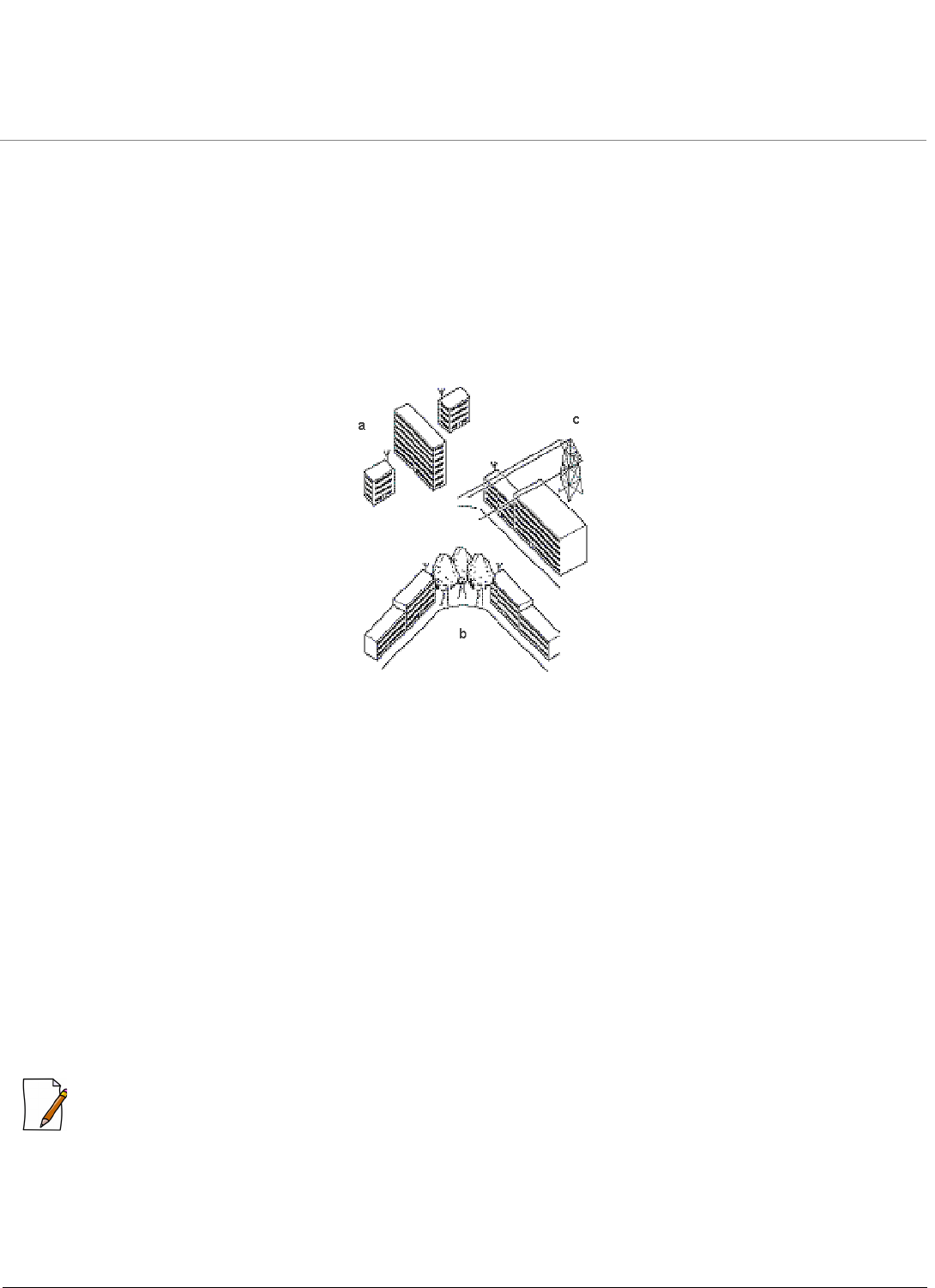
Antenna Installation
Tsunami® MultiPoint 10200 Series - Antenna Installation Guide 8
1.2.2 Determining the Optimal Antenna Placement
To achieve the maximum throughput, the outdoor antenna must have clear line-of-sight with the antenna at the other end.
The outdoor antennas are said to have a clear line-of-sight, when there are:
•No obstacles in the direct path between the antennas (antenna beam)
•No obstacles within a defined zone around the antenna beam
Although, the radio signal can work well without the clear line-of-sight in urban environments, where the signal is
transported by reflection rather than transporting it directly along the obstacles. The following figure shows some typical
examples of obstacles you must avoid in urban environments, for the directional antenna to operate effectively.
Figure 1-1 Obstacles to be avoided: (a) Neighbouring Buildings (b) Tall Trees (c) Power Lines
To minimize the signal interference or reflections due to obstacles, note the following guidelines:
•Mount the antenna as high as possible above the ground to allow maximum clearance.
— In open areas, ‘ground’ is the actual surface of the earth.
— In dense urban areas, ‘ground’ is to be interpreted as the height of the highest obstacle in the signal path
between the two antenna sites.
•Avoid trees in the signal path to avoid signal absorption due to seasonal changes (leaves or ice).
•Install the antenna at least 2 m (6 ft.) away from all other antennas.
Other situations in which reflections of the radio signal may cause interference are environments with large reflecting
surfaces, parallel or partly perpendicular to the antenna beam, such as:
•Mirror-glass buildings.
•Crowded parking lots.
•Water surface, moist earth and moist vegetation.
•Electric power lines and telephone lines above the ground level.
: Reflective surfaces can be used to improve the performance of a link, if the direct line-of-sight is impaired or absent.
In the absence of a direct path or clear line-of-sight, transporting a signal through reflection depends on two factors:
•Fresnel Zone: It is required to calculate the distance of the obstacle from the antenna. See Fresnel Zone.
•Clearance Factor: It is required for optimal performance (See Clearance Factor). Ensure that the type and placement
of the antennas leave sufficient clearance of the Fresnel Zone at the maximum width of the bulge, which is typically at
the mid-point between the antennas.
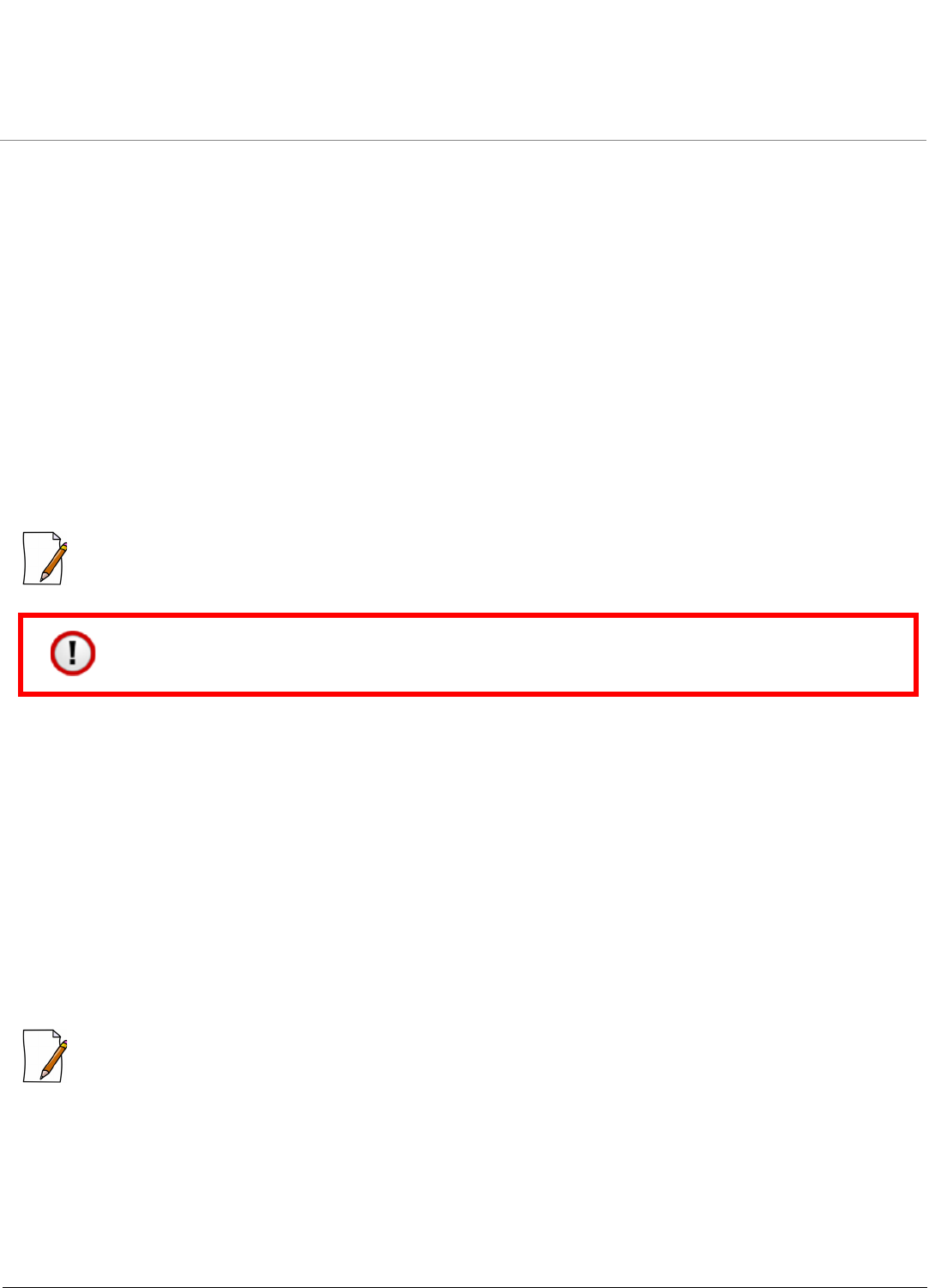
Antenna Installation
Tsunami® MultiPoint 10200 Series - Antenna Installation Guide 9
1.2.3 Mounting the Antenna
Mounting an antenna directly to the wall does not let you align the antenna properly with the corresponding antenna at the
opposite end of your wireless link. Poor antenna alignment typically results in poor performance and therefore, we
recommend mounting the antennas to a mast.
The two methods followed frequently to erect an antenna mast are:
•Tripod Mount: The tripod mount is used primarily on peak and flat roofs. The antenna mast must be secured to the
roof using three or four guy wires equally spaced around the mast. When the height of the antenna mast is more than
3 meters (10 ft.), you should use at least three guy wires for every 3-meter (10-foot) section of the mast.
•Wall (Side) Mount: A wall (side) mount allows you to mount the antenna (mast) on the side of a building or on the
side of an elevator penthouse. This provides you with a convenient mounting location, when the roof overhang is not
excessive or when the location is high enough to provide a clear line-of-sight.
When mounting multiple antennas on a single mast, use the following methods to minimize the influence of cross-talk
interference between the antennas:
– Place your antennas as far as possible.
– Mount the directional antennas, such that the identical side of both the antennas face the same direction.
: As the mounting procedures for the various antennas differ from one another, refer to the guide that comes along
with the antenna.
1.2.3.1 Antenna Mast Requirements
To accommodate the antennas, the antenna mast must satisfy the following requirements:
•The construction of the antenna mast must contain sturdy, weatherproof, and non-corrosive material (for example,
galvanized or stainless steel construction pipe).
•Diameter of the mast should be between 35 mm (1.4 inches) and 41 mm (1.6 inches). The diameter of the antenna mast
vary depending on the type of antenna you intend to install.
•The height of the antenna mast must be high enough to allow the antenna to be installed at least 1.5 m (5 ft.) above the
roof. The height of the antenna should be at least 3 m (10 ft.) above, if it is a metal roof.
•The antenna mast or wall bracket must be free from any material (like paint) that prevents a good electrical conduction
with the antenna.
1.2.3.2 Antenna Tilt Angles and corresponding EIRP values
: The below mentioned particulars are applicable only to the devices operating in U-NII-1US frequency band
5.15 GHz - 5.25 GHz.
The Federal Communications Commission (FCC) established new rules for the 5.15 GHz - 5.25 GHz U-NII-1 band in the
Report and Order FCC-14-30A1 are effective from June 2nd, 2014. With the help of professional installation, all the Proxim
devices can be configured to comply with the power requirements set in the rules. For an angle of elevation which is above
30 degrees, the maximum EIRP limit should be set to 125 mW (21 dBm). The compliance can be achieved through proper
selection of antenna, angle of elevation, and Tx power control to provide reasonable protection from harmful interference to
users, authorized devices, and co-channel NGSO/MSS operations.
: The antennas installed at both the ends of a wireless link should maintain same antenna
polarizations.
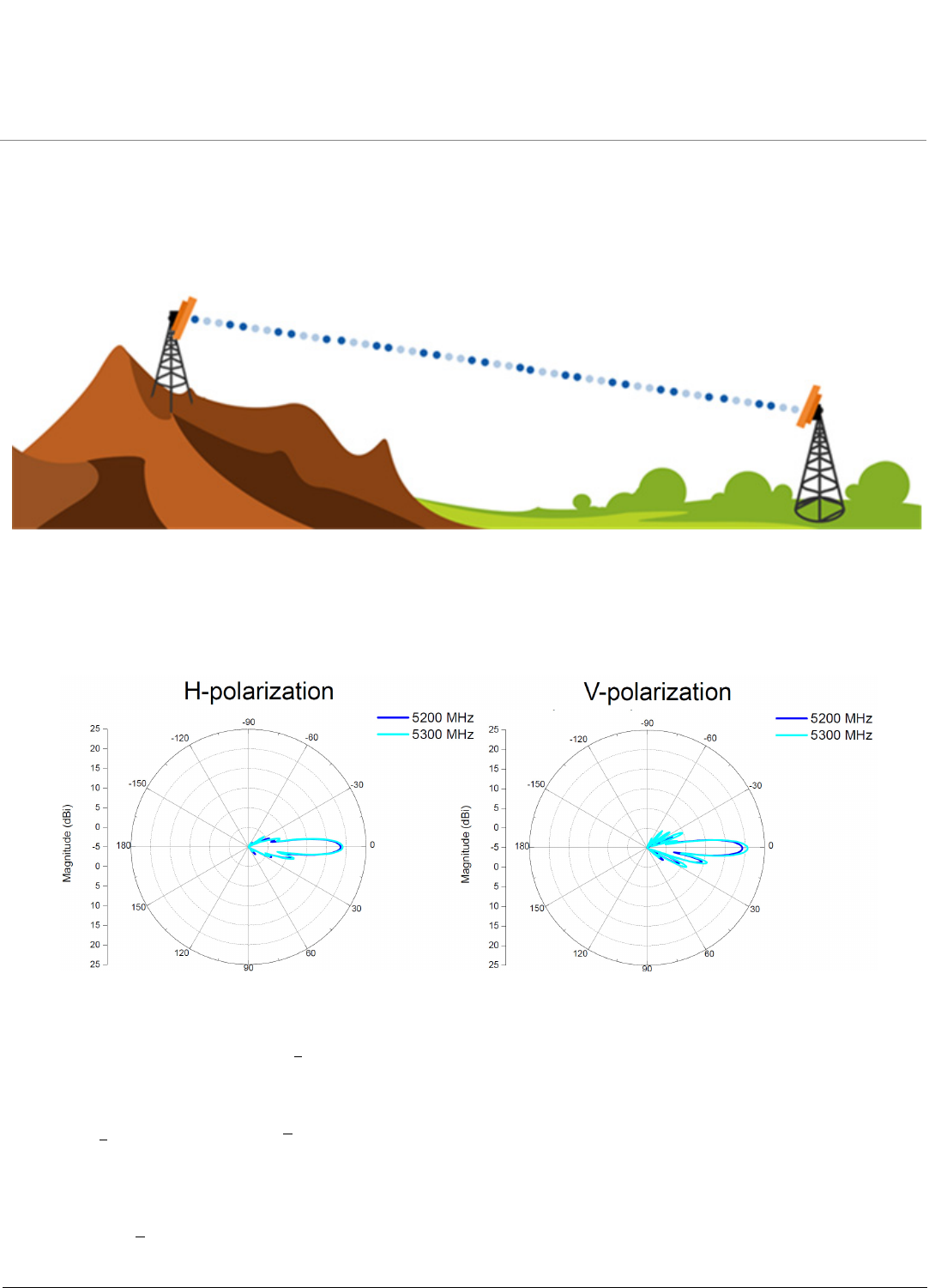
Antenna Installation
Tsunami® MultiPoint 10200 Series - Antenna Installation Guide 10
The antenna/devices located at different altitudes should be tilted at the correct angle to efficiently transmit/receive the
signals between the devices in the wireless network. The following figure shows the antenna tilt and its importance when the
successive devices are located at different elevations above the ground.
Figure 1-2 Typical installation showing device/antenna tilt angle
The radiation patterns for a device with Horizontal polarized antenna in Azimuthal and Elevation planes are shown below
in Figure 1-3. As per the regulatory domain, there are no limitations to the Azimuthal plane with respect to EIRP, but the
Elevation plane has a limit specific to EIRP above 30 degrees as 21 dBm. To comply with this specification, Proxim products
have an option to control the transmit power based on the installation tilt angle and the radiation pattern of the antenna.
Figure 1-3 Antenna radiation patterns for Azimuthal and Horizontal Planes
The formula used for the calculation of Transmit Power is given below:
Transmit Power = EIRP - G (30- 0) - MIMO Gain
Where,
EIRP - Equivalent Isotropically Radiated Power
G (30- 0) - Antenna gain at (30- 0) in the elevation plane
MIMO Gain - Gain for Multi Input Multiple Output products (2x2 MIMO Gain is 3 dB and 3X3 MIMO Gain is 4.8 dB)
•The calculation of Transmit Power to comply with the EIRP limits for an antenna with a gain of 22 dB is explained below
for three different tilt angles:
•Case 1: 0 = 00 (No antenna tilt)
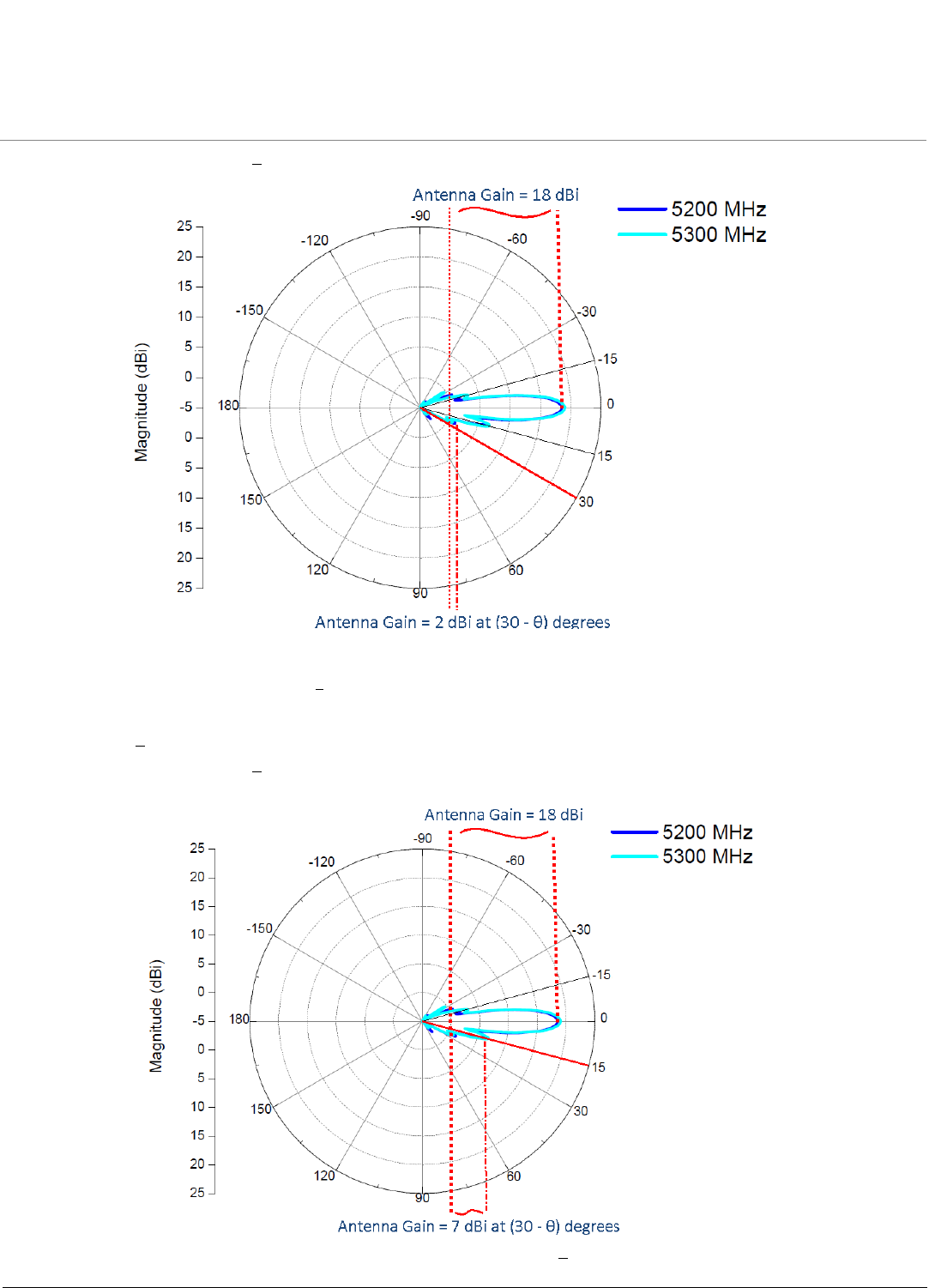
Antenna Installation
Tsunami® MultiPoint 10200 Series - Antenna Installation Guide 11
– The antenna gain for 0 = 00 is shown in the following figure:
Figure 1-4 Antenna gain at (30- 0) = 300
– Transmit Power = EIRP - G (30- 0) - MIMO Gain
= 21 - 5 = 16 dBm
•Case 2: 0 = 150 (antenna tilted upward)
– The antenna gain for 0 = 150 is shown in the following figure:
Figure 1-5 Antenna gain at (30- 0) = 150
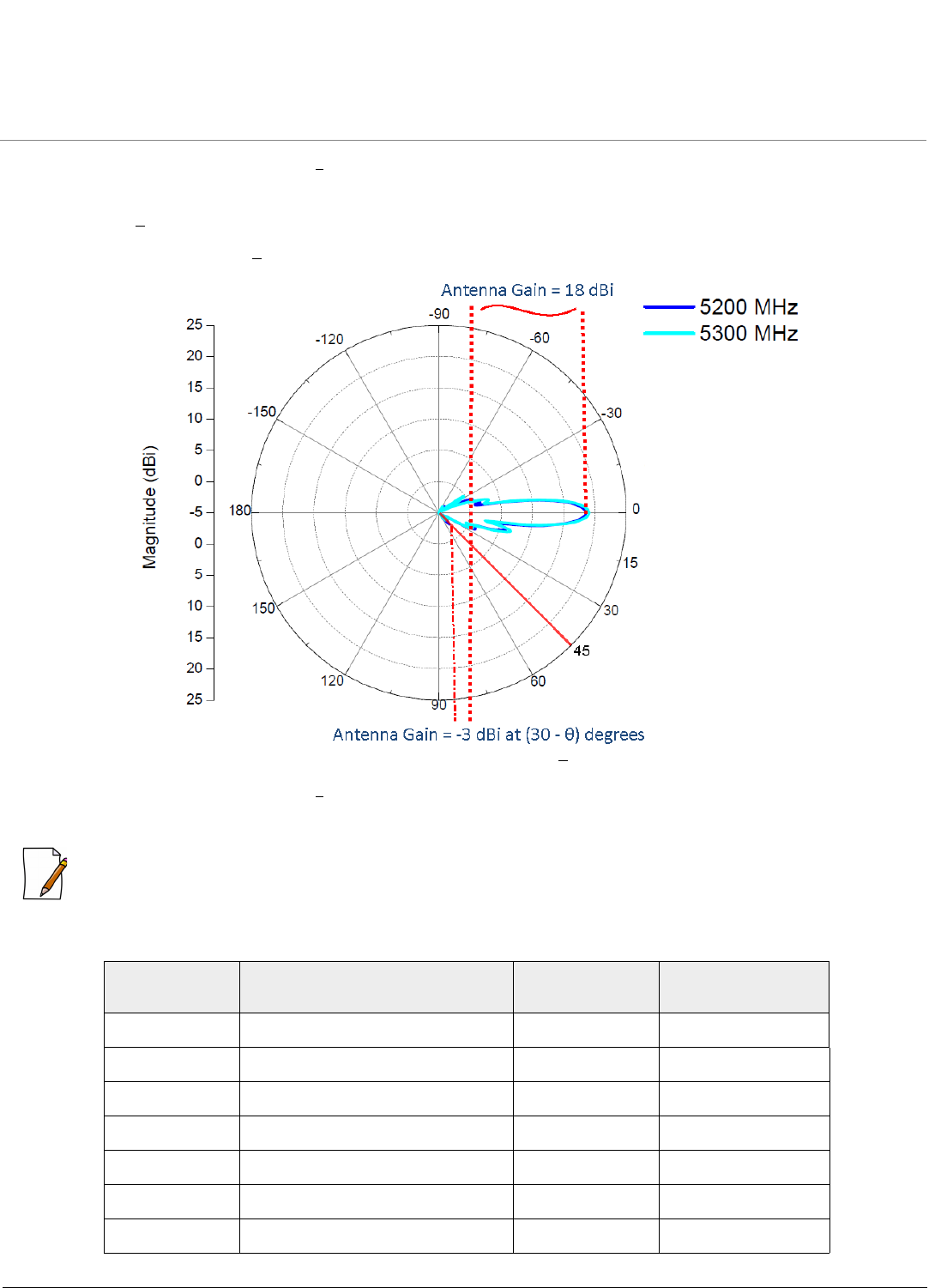
Antenna Installation
Tsunami® MultiPoint 10200 Series - Antenna Installation Guide 12
– Transmit Power = EIRP - G (30- 0) - MIMO Gain
= 21 - 10 = 11 dBm
•Case 3: 0 = -150 (antenna tilted downward)
– The antenna gain for 0 = -150 is shown in the following figure:
Figure 1-6 Antenna gain at (30- 0) = 450
– Transmit Power = EIRP - G (30- 0) - MIMO Gain
= 21 - 0 = 21 dBm
:
• -10 degree indicates that the antenna is tilted downwards.
• 10 degrees indicates that the antenna is titled upwards.
Tilt Angle
(degrees)
Allowed Transmit Power per
Single chain (dBm)
EIRP of Product
(dBm)
Remarks
01237
-10 13 42
-20 13 38
-30 17 42
10 10 35
20 10 35
30 -5 21 Not Recommended
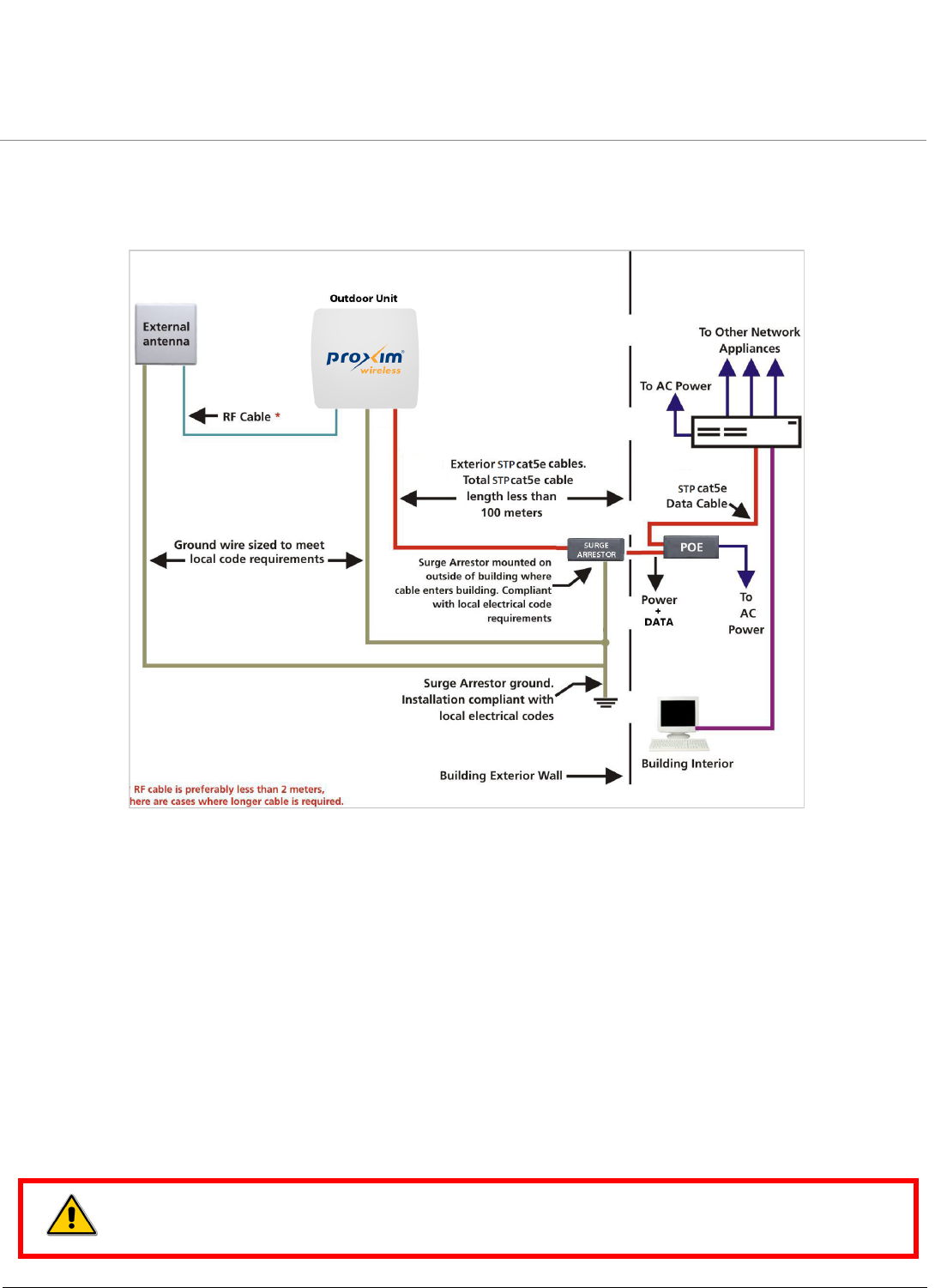
Antenna Installation
Tsunami® MultiPoint 10200 Series - Antenna Installation Guide 13
1.2.4 Connecting the Cables
Once the outdoor antennas are properly mounted, the cable setup essential to complete the outdoor antenna installation is
depicted in the following figure:
Figure 1-7 Cable Setup
The entire outdoor cabling setup requires the following cabling to be done:
1. Connecting the Antenna Cable
2. Connecting the Surge Arrestor and Ethernet / Power cables
3. Grounding the System
1.2.4.1 Connecting the Antenna Cable
Follow the following steps to connect an antenna to the device, by using an antenna cable.
1. Use an RF cable (antenna cable) to connect the outdoor device to an external antenna.
2. Connect the right-angled N-male connector of RF cable on the antenna. The antenna cables run from the external
antenna to the N-Type connectors on the device. The N-Type connectors have built-in surge protection.
3. Secure the antenna cable to the antenna mast, as the cable connectors do not support the full weight of the cable.
4. Connect the other end of the antenna cable to the device.
: Do not use tools to tighten the cable connectors, as they damage the antenna cable and connectors.
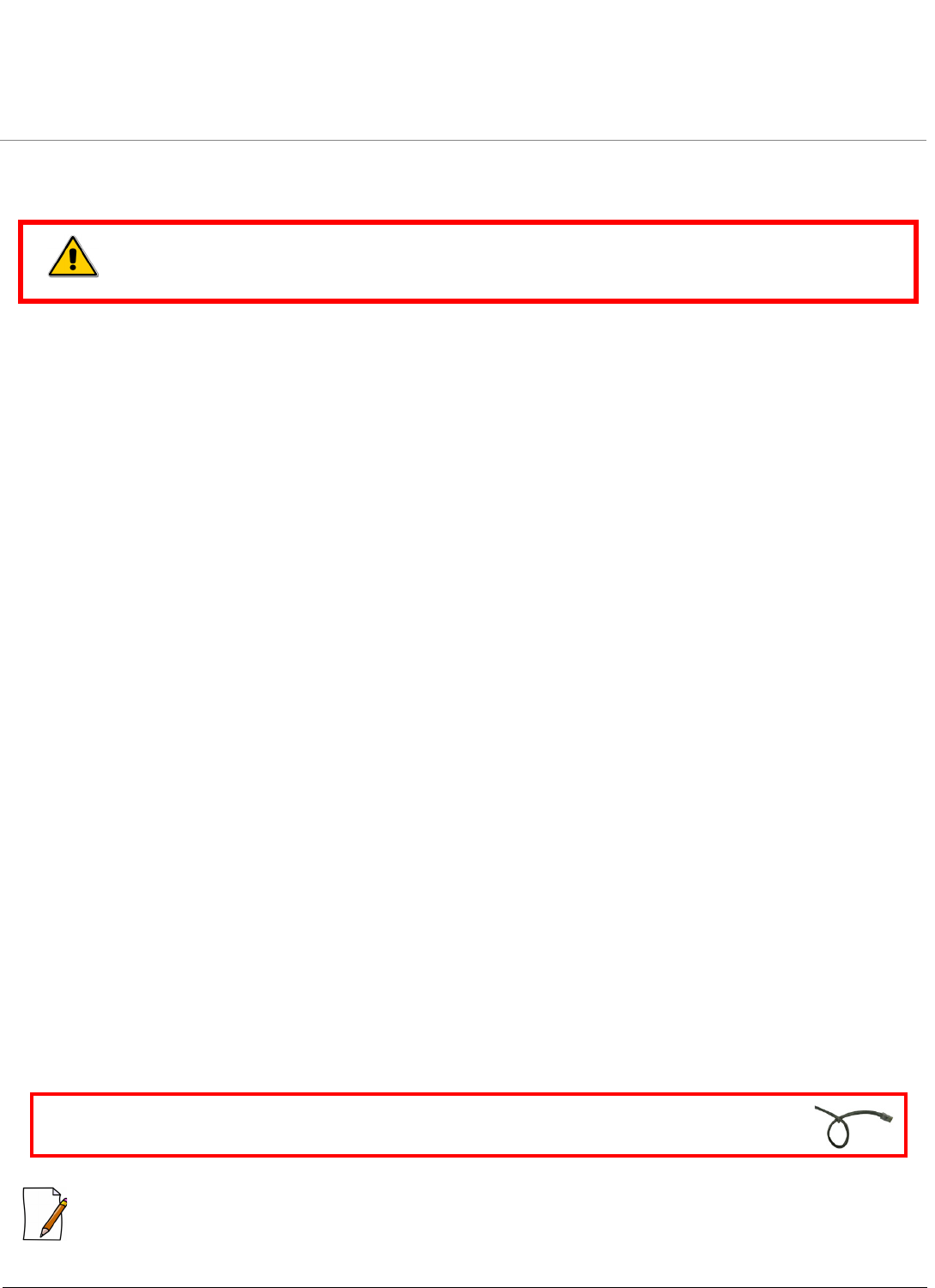
Antenna Installation
Tsunami® MultiPoint 10200 Series - Antenna Installation Guide 14
5. If required, adjust the direction of the antenna.
6. Tighten the nuts of the antenna to lock the antenna into its position.
7. Secure the cable along its complete length with a cable or electrical tape to relieve strain on the antenna connector. No
part of the cable should be allowed to hang free, especially the parts that are routed outside the building.
8. Weatherproof all the outdoor connectors. See Sealing the Cable Connectors.
Ensure you follow the below guidelines while using the antenna cable:
•The entire cable used must be secured and no part of the antenna cable should be allowed to hang free, precisely the
outdoor cable parts.
•The antenna cable and cable connectors are not designed to withstand excessive force.
•Do not use the connectors like ‘cable grips’, to pull the cable through raceways or conduits.
— Do not use the cable connector to support the weight of the cable during or after installation.
— Do not use any tool to tighten the connectors.
•Always seal the connectors using the weatherproofing tape.
•Avoid any water or moisture entering the cable, as it impacts the performance of the wireless link.
•Prior to sealing the outdoor connectors and permanently securing the cable to the wall with cable ties and wall hooks,
assure that the components that are installed are functioning properly.
Antenna Cable Routing
The antenna cable must be routed and fixed in such a way, that the installation technicians have a clear passage area. All the
connectors that are located outdoor must have a weatherproof seal. We recommend you to seal the connectors only after
completing the final radio test. See Sealing the Cable Connectors.
1.2.4.2 Connecting the Surge Arrestor and Ethernet / Power cables
Perform the following steps to ensure proper surge protection, and ethernet or power cabling:
•Connect the surge arrestor near the outdoor device with a CAT5e ethernet cable (properly ground it near to the cable
ingress point of the building, complying with the local electrical code requirements).
•Connect the RJ 45 Data In / LAN-IN / IN port on the POE (power injector) and the network interface card of the
personal computer with a Cat5e ethernet cable.
•Plug one end of the Cat5e ethernet cable into the ethernet port of the surge arrestor (near building ingress point) and
connect the other end of the cable to the Data & Power Out / PWR LAN-OUT / OUT port on the POE. Ensure that
the cable connector is latched securely.
•Connect the remaining ports on both the surge arrestors (one near the outdoor device and other at the building
ingress point) with an RJ 45 terminated cable.
: It is mandatory to install an approved lightening surge protector at the building ingress point. If the device is installed
in a region subjected to violent thunderstorms or severe weather conditions, then installation of an additional
: Avoid over-tightening of the connector, nuts and screws that are used to mount the antenna, to
protect the antenna and device from getting damaged.
IMPORTANT! Ensure to loop the cable before entering the premise to prevent water ingress.
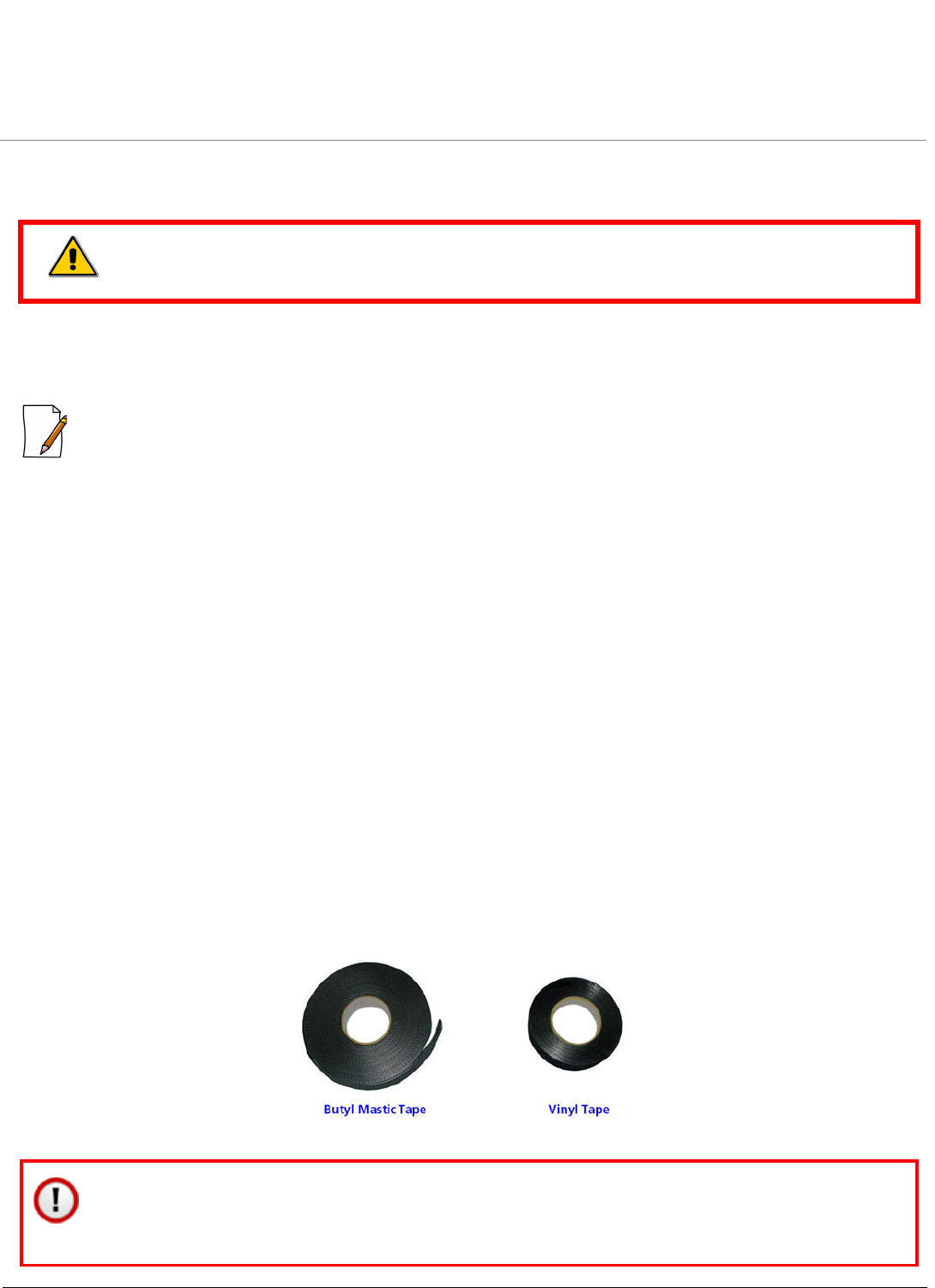
Antenna Installation
Tsunami® MultiPoint 10200 Series - Antenna Installation Guide 15
approved lightening surge protector near the device is recommended. To buy an additional Surge Protector
(Part Number: 235-00001), place an order separately with your distributor.
1.2.4.3 Grounding the System
Direct grounding of the antenna mast, device, and surge arrestor is extremely important. Refer to the Quick Installation
Guide, that comes along with your product, for detailed illustration on grounding the outdoor device and surge arrestors.
: A safety grounding system is necessary to protect your radio from lightning strikes and the static electricity generated
from it.
Grounding the Antennas
Following precautions should be satisfied, while grounding the antenna:
•The antenna mast and the grounding system should be installed only by qualified installation professionals and
electrician, who are familiar with local building, safety, and electrical codes in the country of use.
•The antenna mast, the device, and the surge arrestor must be connected to the same ground, by using an equi-
potential bonding conductor.
•A good electrical connection should be made to one or more ground rods, by using at least a 10 AWG ground wire
and non-corrosive hardware.
1.2.5 Sealing the Cable Connectors
Corrosion of the antenna cable, cable connectors and other wireless outdoor installations degrade the performance of the
wireless link. To avoid, you must always seal the outdoor cable connectors using weatherproofing tape. To weatherproof the
antenna connectors at both the ends of a wireless link, follow the following step-by-step procedure:
1. Collect the required material:
The material required for weatherproofing connectors are,
•Any standard Butyl Mastic Tape
•Any standard Vinyl Tape
We have used the following Butyl Mastic Tape and Vinyl Tape as an example to demonstrate the weatherproofing steps:
2. Follow the following weatherproofing steps:
: The surge arrestor and the antenna mast must be connected to the same grounding system, by
using the shortest cable possible, as prescribed by local electrical codes.
: We have taken MP-8xxx-BSU and external antenna as an example to explain the weatherproofing
steps. Follow the same method to weatherproof the antenna connectors of the Tsunami® MultiPoint
10200 Series products.
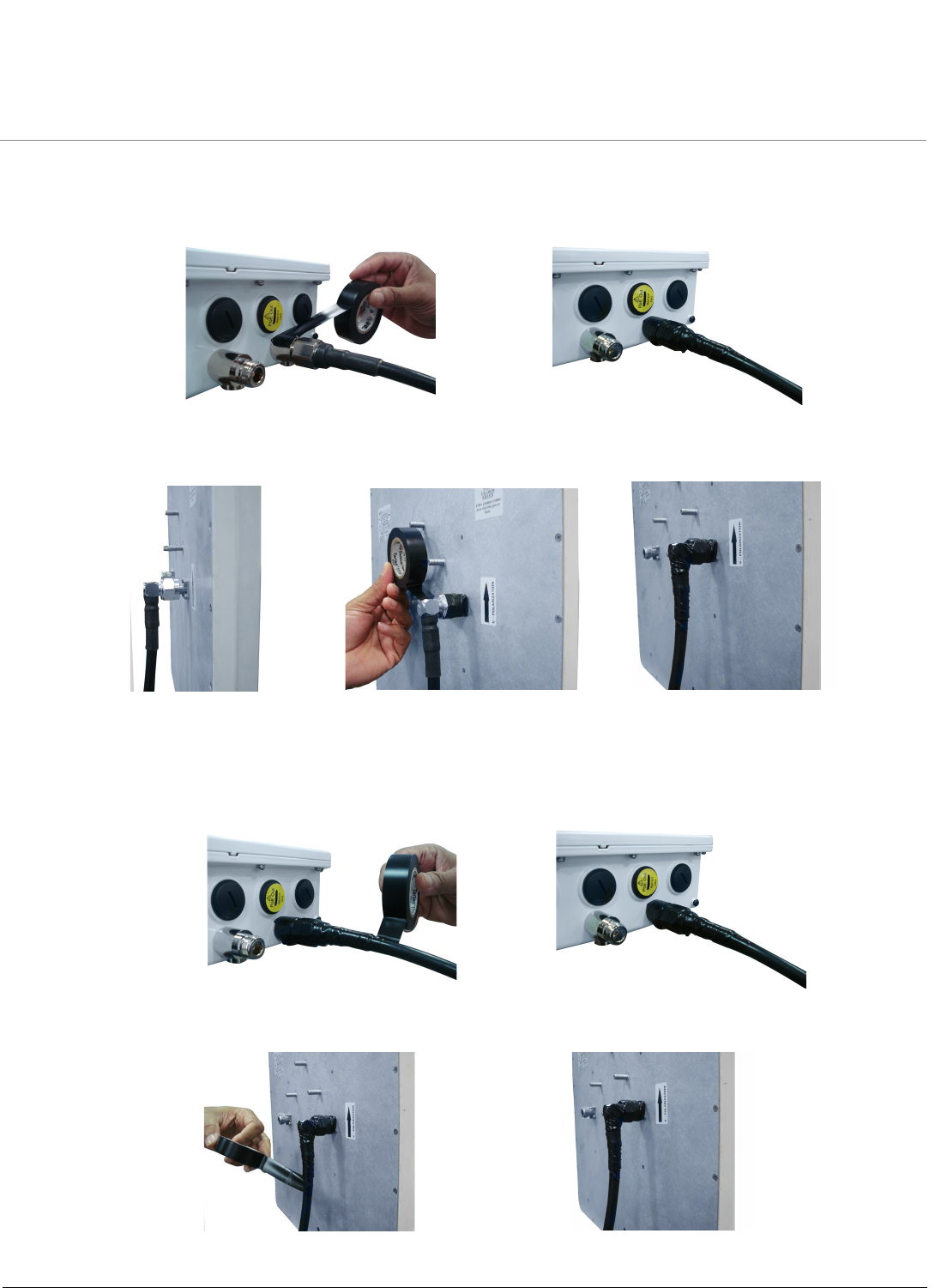
Antenna Installation
Tsunami® MultiPoint 10200 Series - Antenna Installation Guide 16
Step 1: Wrap vinyl tape in a half-lapped fashion, from the weatherproof connector end and continue wrapping down 3
inches onto the CAT5e cable.
a. Weatherproofing at the device end:
b. Weatherproofing at the antenna end:
Step 2: Wrap a second layer of vinyl tape in the reverse direction over the first layer of tape.
a. Weatherproofing at the device end:
b. Weatherproofing at the antenna end:
(a) (b)
(a) (b) (c)
(a) (b)
(a) (b)
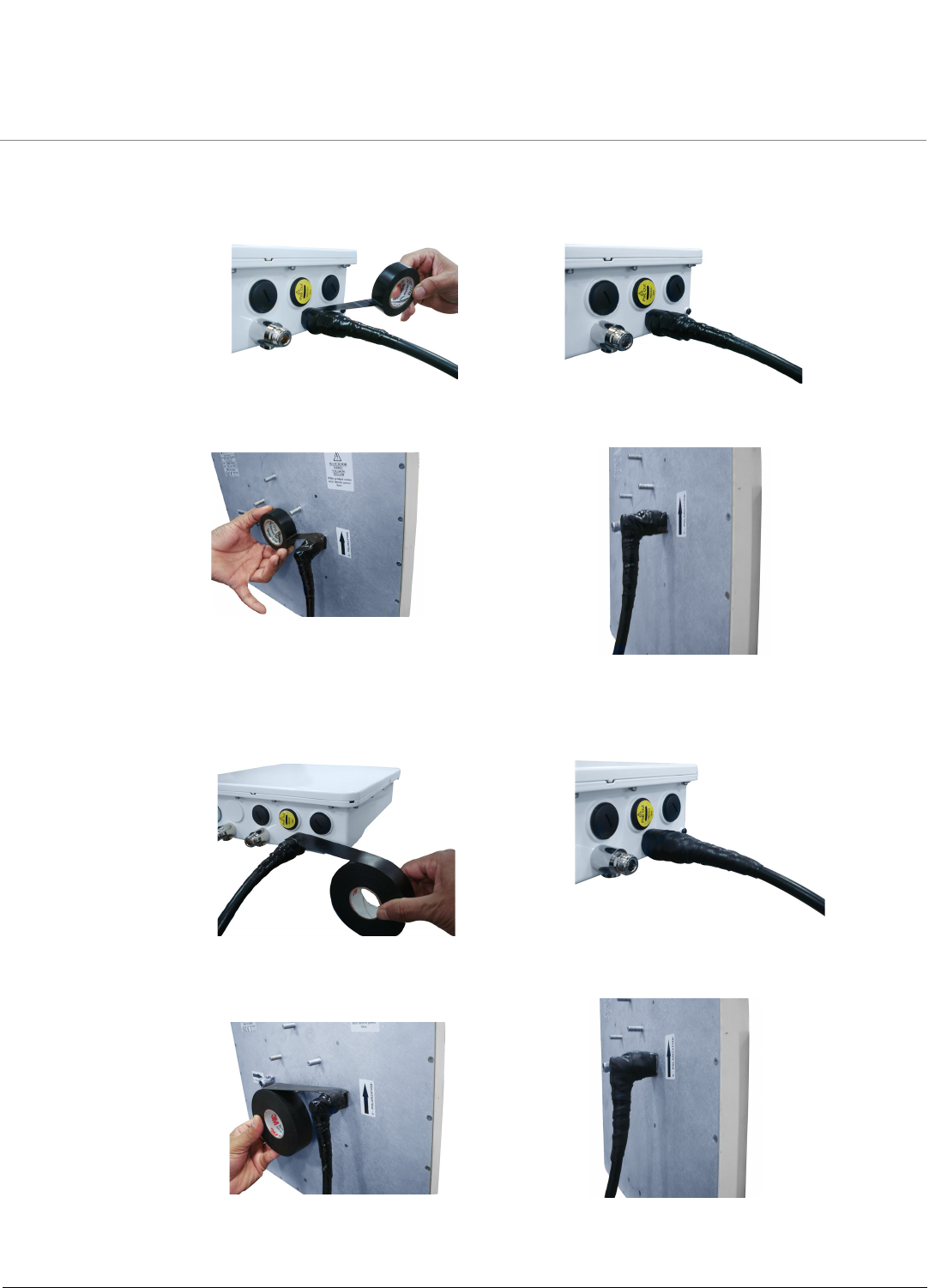
Antenna Installation
Tsunami® MultiPoint 10200 Series - Antenna Installation Guide 17
Step 3: Now, wrap a third layer of vinyl tape over the other two layers but with the adhesive side up as this provides a sticky
surface for the next layer.
a. Weatherproofing antenna connectors on the device:
b. Weatherproofing antenna cable:
Step 4: Next, wrap a layer of the butyl mastic tape over the adhesive side of the tape, covering all of the tape and connector.
a. Weatherproofing antenna connectors on the device:
b. Weatherproofing antenna cable:
Step 5: Wrap vinyl tape over the butyl layer and cover the entire tape assembly.
(a) (b)
(a)
(b)
(a) (b)
(a) (b)
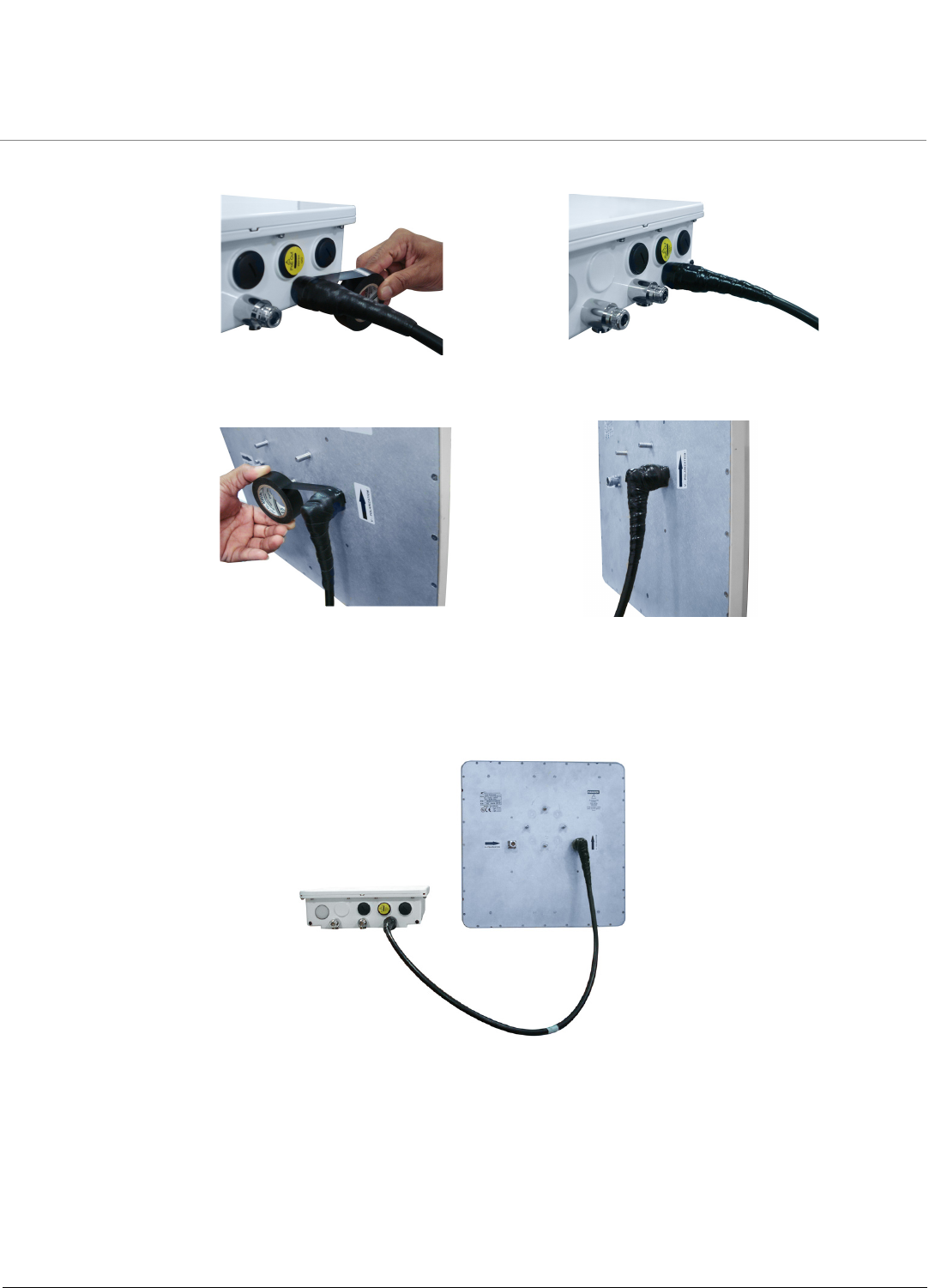
Antenna Installation
Tsunami® MultiPoint 10200 Series - Antenna Installation Guide 18
a. Weatherproofing antenna connectors on the device:
b. Weatherproofing antenna cable:
Step 6: Place a small zip tie over the last wrap of tape to prevent it from unwrapping over time.
The figure below depicts the complete weatherproofing of the RF connection.
1.2.6 Aligning the Antenna
Antenna alignment is the process of physically aligning the antenna of the radio receiver and transmitter to establish a link
with a better throughput. The antenna alignment process is usually performed during the installation of the antennas. You
can align the antennas by using the following two methods:
•Antenna Alignment using CLI Commands
•Antenna Alignment using RSSI Light Pipe
Alternatively, consult an antenna installation service professional to optimize the antenna alignment.
(a) (b)
(a) (b)
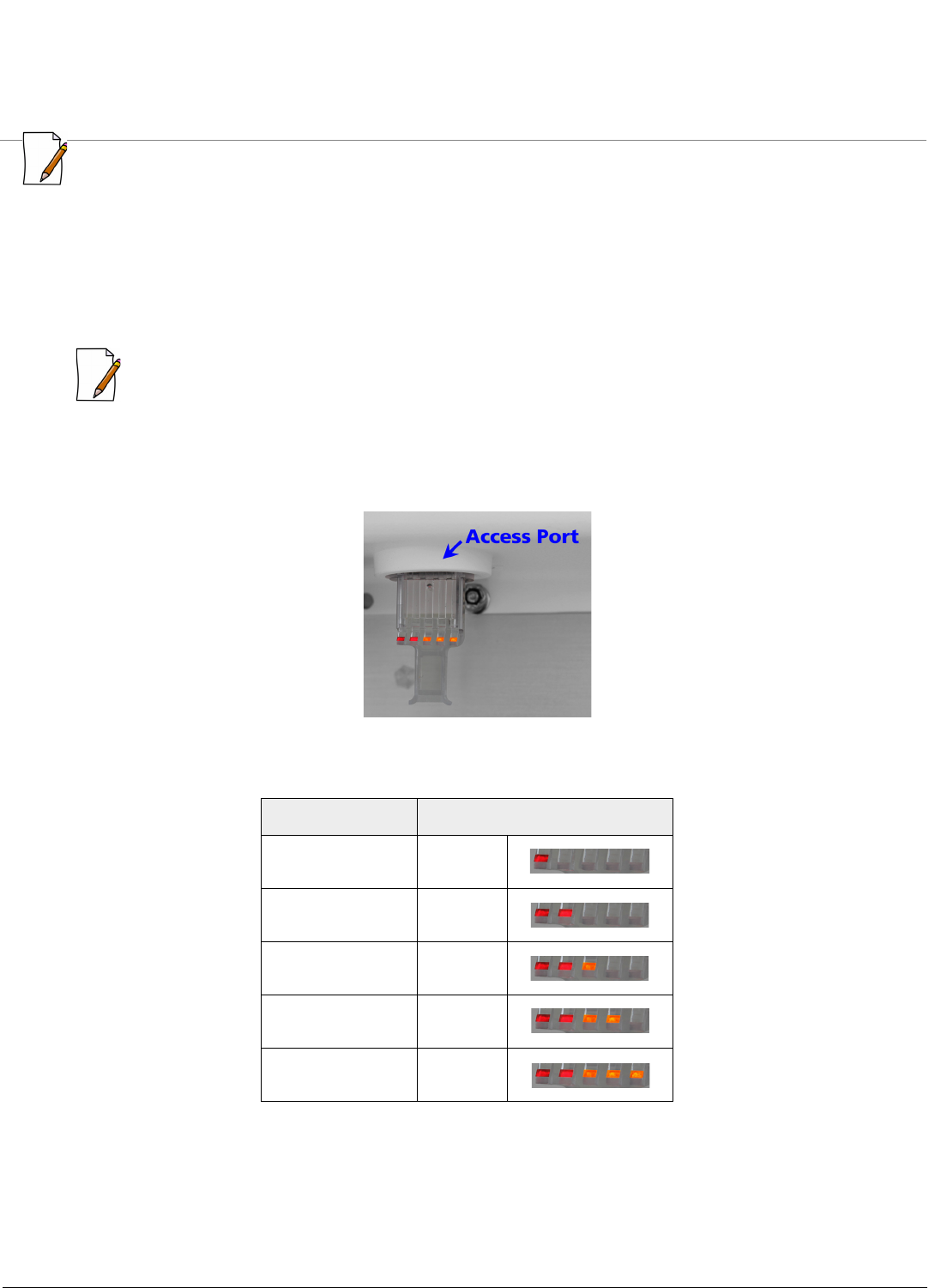
Antenna Installation
Tsunami® MultiPoint 10200 Series - Antenna Installation Guide 19
: Applicable only to the devices with the back-haul feature (i.e., devices with 5 GHz Antennas).
1.2.6.1 Antenna Alignment using CLI Commands
To enable the antenna alignment display from the CLI prompt, enter the following commands:
•aad enable local: Enables display of the local signal, noise and SNR.
•aad enable remote: Enables display of the remote signal, noise and SNR.
•aad enable: Enables display of local and remote signal, noise and SNR.
:Use a flat blade screw driver to disconnect and pull out the serial cable from the enclosure after the antenna
alignment is done. After withdrawing the cables, seal the serial port carefully to avoid water seepage.
1.2.6.2 Antenna Alignment using RSSI Light Pipe
To assist alignment, the device can use a RSSI Light Pipe (supplied) to easily view the RSSI LEDs implemented in device’s Access
Port.
RSSI Light Pipe helps to align/adjust the antennas such that the signal between the devices is optimal. The number of RSSI
LEDs which glow in the RSSI Light Pipe as per the signal level are as below:
SNR Range (dB) Number of glowing RSSI LEDs
1 – 12 1
13 – 18 2
19 – 24 3
25 – 30 4
> 30 5

Tsunami® MultiPoint 10200 Series - Antenna Installation Guide 20
2
Measuring Signal Performance
2.1 Introduction
The performance of a microwave link (wireless link established between two outdoor antennas) is closely related to the
following factors:
•Range
•Fresnel Zone
•Clearance Factor
Calculating the above factors help you align the antennas properly and achieve a better throughput.
2.2 Determining the Range
Range is the maximum distance a microwave link travels and is based on the:
•Type of the outdoor antenna equipment (Outdoor antennas differ in technical specifications).
•Data speed of the wireless link.
•Clearance of the signal path (see Clearance Factor).
Use the following formula to determine the range of the microwave link:
Range = Maximum Range x Clearance Factor
1. Maximum Range: It is the theoretically calculated value achieved under optimal circumstances, by using the
available products and their technical specifications that comply with the local radio regulations. The calculations
made assuming the optimal radio conditions do not guarantee of achieving the same maximum distance at your
location.
2. Clearance Factor: See Clearance Factor.
Variations in calculations of the above two factors occur due to any of the following reasons:
•Incorrect alignment of antennas.
•Polarization mismatch of the antennas.
•Sources of interference or unexpected reflections in the signal path that affect the quality of communication (Refer
Determining the Optimal Antenna Placement).
•Severe weather conditions such as heavy rainfall, snow or strong winds.
•Unexpected obstacles in the link path.
•Seasonal influences such as leaves on trees or icing of the antennas.
2.3 Fresnel Zone
The narrow antenna beam emerged from the antennas contain a bulged area called as Fresnel Zone. The first Fresnel Zone is
known to be an imaginary boundary line offset along the direct path of the signal, where a signal reflected will travel an
additional one-half distance of wavelength. Each succeeding Fresnel Zone boundary adds an additional half-wavelength to
the reflected path distance than the direct signal path between the antennas.
When any significant part of the Fresnel Zone is obstructed, a portion of the radio energy is lost that results in reduced
performance. Reduced performance can also occur when obstacles close to the antenna beam cause signal reflections or
noise that interfere with the radio signal.
Weather conditions (rain or snow) usually do not have much impact on the performance of your device, provided you have
sealed all the cable connectors with weatherproofing tape. Seasonal influence on signal propagation can occur in the
following situations:
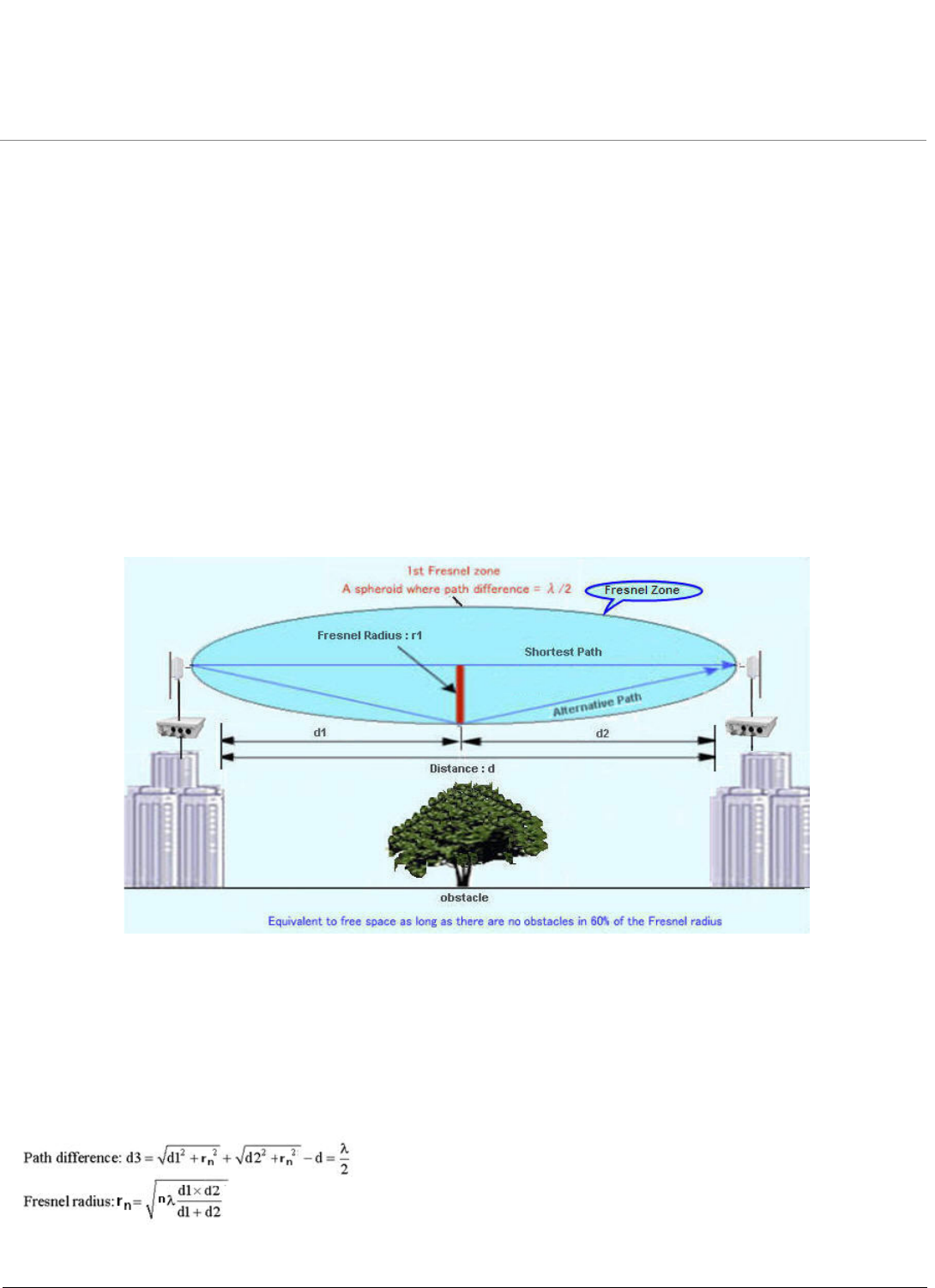
Measuring Signal Performance
Tsunami® MultiPoint 10200 Series - Antenna Installation Guide 21
•Marginal communications quality in late fall (with no leaves on the trees along the signal path) might fail in the
summer (with leaves on the trees along the signal path).
•In winter, a wireless link can fail when the antenna is exposed to ice buildup or when the antenna elements are
covered with snow.
Radio paths over water or extremely flat ground require optimization of antenna height at one end. This is due to in-phase or
out-of-phase reflections. Adjustment of antenna height by 1 to 3 meters may move the signal from null to peak.
Long distance links may be obstructed by earth curvature, so the antenna height requirements must not only take the height
of obstructions and Fresnel Zone into account but also the earth bulge. The earth bulge is approximately 5 meters (16.4 ft.) at
a link distance of 16 Kilometers (10 millimeters). Consult your supplier to take appropriate steps to maintain or optimize
wireless link performance.
2.3.1 Fresnel Zone Calculation
The exact shape and width of the Fresnel Zone is determined by calculating the Fresnel Radius. The distance between the
Fresnel Zone boundary and a straight line running along the signal path (shortest path) between the antennas is called the
Fresnel Radius. Fresnel Radius can be determined by using the path difference (difference between the shortest path and
alternative path) and frequency of the radio signal. If there are no obstacles in the space forming 60% of the path difference,
then the propagation characteristics are said to be the same as that in free space.
Figure 2-1 Fresnel Zone Calculation
Let’s say, in the above figure:
–d1 is the distance between the obstacle and the antenna at one end.
–d2 is the distance between the obstacle and the antenna at the other end.
– is the wavelength of the operating frequency.
Then, Path Difference (d3) and Fresnel Radius (rn, radius of the nth Fresnel Zone) can be calculated from the formula below:
λ
(where n = 1, for the first Fresnel Zone and rn = r1)
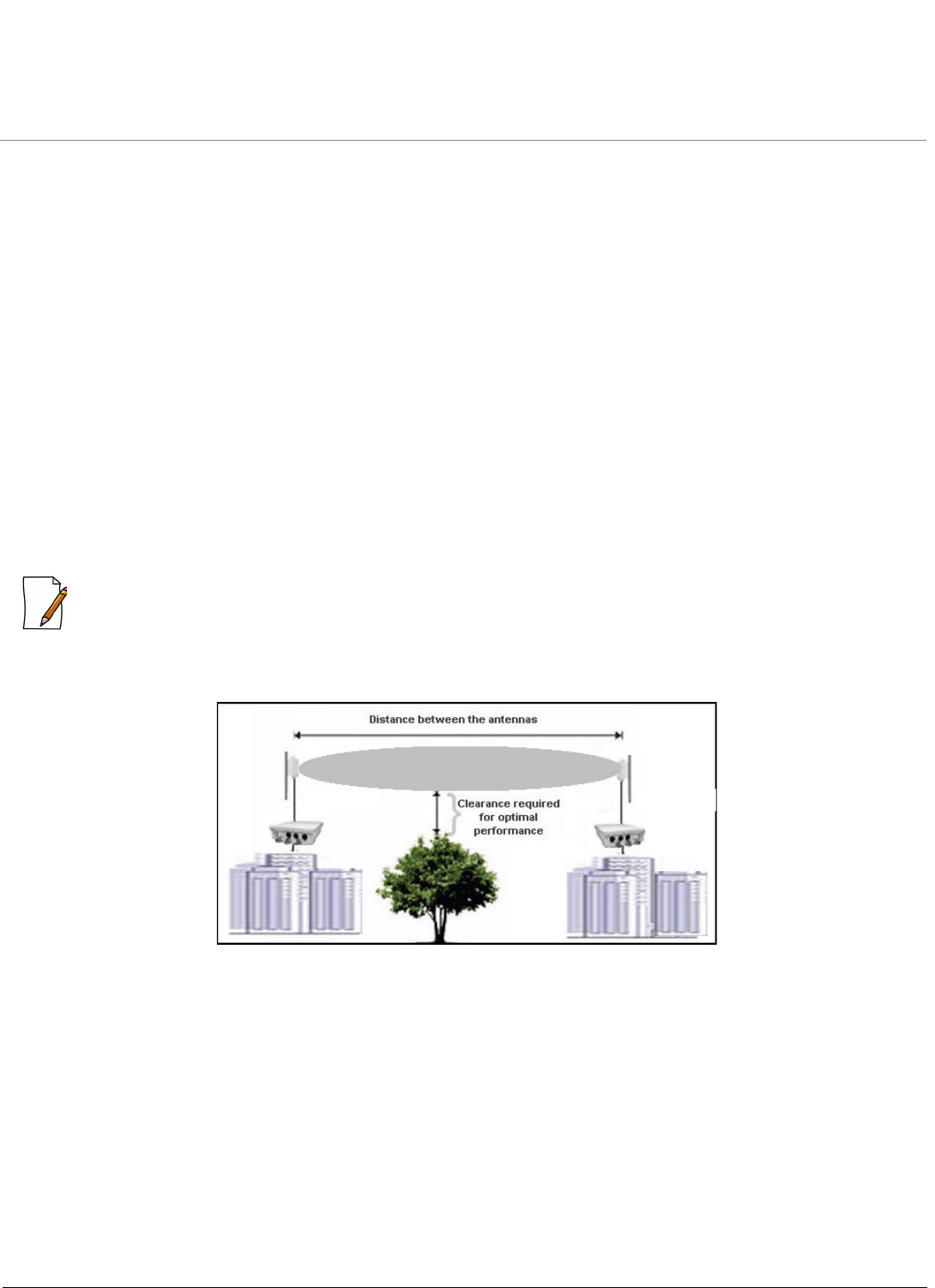
Measuring Signal Performance
Tsunami® MultiPoint 10200 Series - Antenna Installation Guide 22
The path difference is the required clearance of the antenna beam from obstacles in its path to avoid loss of radio signal.
Signals reflected from any even-numbered Fresnel Zone result in signal cancellation while the odd-numbered Fresnel Zones
add to the direct path signal.
2.4 Clearance Factor
Clearance Factor is a correction value (in percentage) that should be used in case, where the signal path of your wireless link
does not provide the minimum clearance as listed in the Maximum Range Table. In general, clearance factor is taken as 60%
of the Fresnel Zone and is calculated as:
Clearance Factor = Fresnel Zone x 60%
For optimal performance of your outdoor wireless link, the signal path between the BSU and SU must provide sufficient
clearance. Clearance is interpreted as:
– The total height above the surface of the earth, in the open areas without obstacles in the signal path. Let’s say
antenna is mounted on the roof, then clearance is the total height including the height of the building and the height
of the mast above the rooftop.
– The height above the highest possible obstacle, in the areas with obstacles along the signal path (path between two
antennas).
– The height above the rooftop or highest obstacle in the signal path, in dense urban areas.
: An outdoor wireless link that lacks sufficient clearance will exhibit poor performance, which is typically perceived as
slow network response time. However, your radio equipment automatically retransmits every lost data frame due to
an out-of-range situation or frame collision. The larger the number of retransmissions, the lower is the throughput
efficiency of your wireless link.
Figure 2-2 Clearance required for the Optimal Performance
As shown in the above figure, the clearance required for optimal performance is interpreted as:
– Vertical clearance above the ground and the highest buildings or objects along the signal path
– Horizontal clearance from neighboring buildings and objects along the signal path
For optimal range and throughput performance, you must ensure that your antenna installation provides maximum clearance
in both horizontal and vertical directions.
If the local authorities, proprietor of the premises or other miscellaneous factors do not allow you to set up an antenna mast
for the clearance requirements, then you may not achieve a full line-of-sight clearance. However, if the distance that your
wireless outdoor installation covers is less than the listed maximum range, you don’t need full clearance.
To determine the effect of insufficient signal path clearance, you must determine the Clearance Factor and also calculate its
effect on the range for your antenna installation, by using the formula described in Determining the Range.
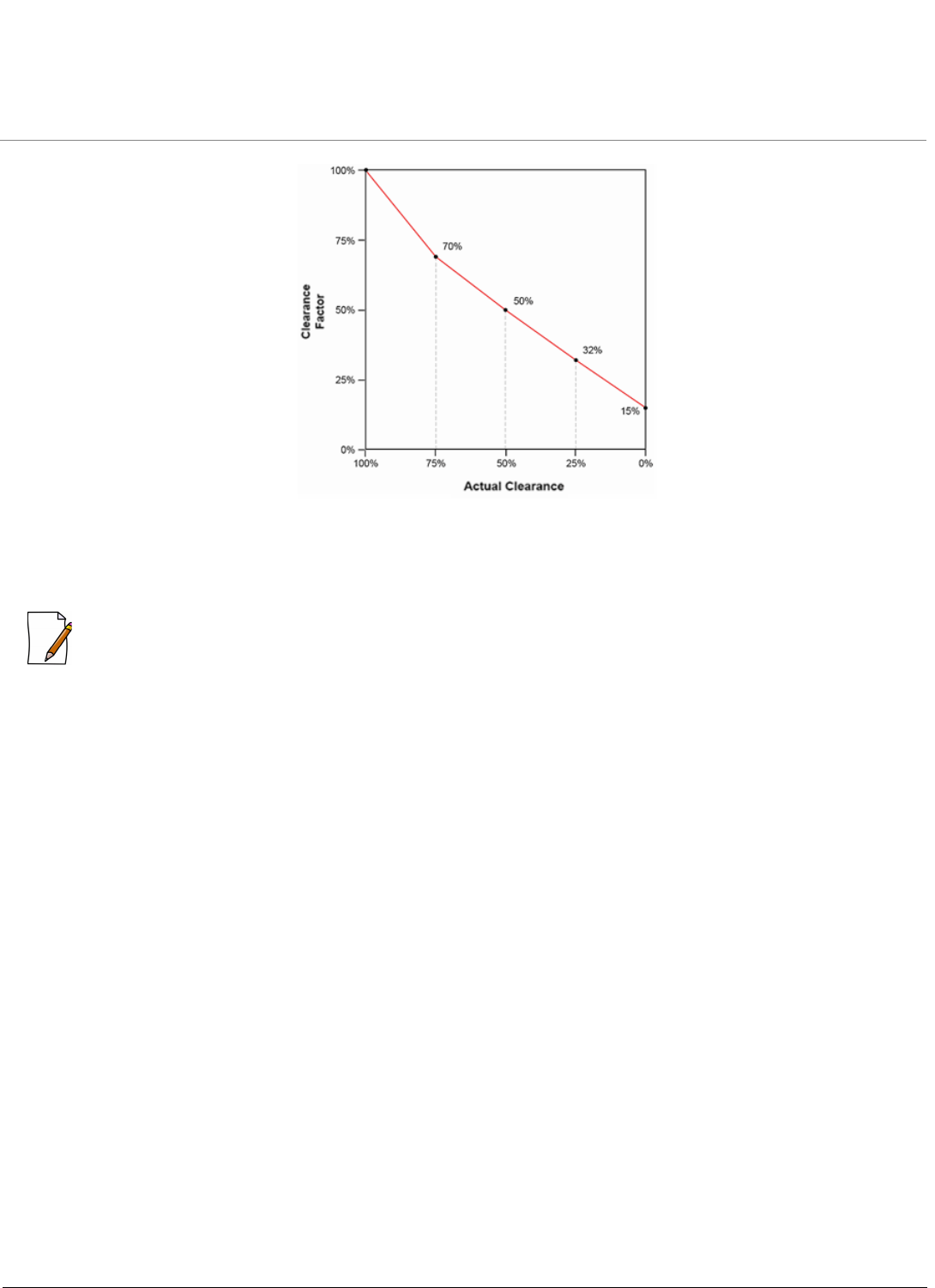
Measuring Signal Performance
Tsunami® MultiPoint 10200 Series - Antenna Installation Guide 23
Figure 2-3 Clearance Factor
If the clearance for your antenna installation is equal to or better than the minimum clearance required, then the Clearance
Factor for your installation is 100%. If your actual clearance is less than the minimum clearance, then refer the above figure to
determine the actual range that applies to the current requirement.
: Practically, it is impossible to achieve the maximum range due to the interference from the other radio products.
Proxim recommends you to maintain at least 60-70% of the first Fresnel Zone free. If the clearance is lower than this
percentage, then the link budget and acquired fade margin are affected. Clearances more than 100% of the Fresnel Zone can
cause reflections that are 180 degrees out of phase and can cancel the signal. The Fresnel Zone works in both the horizontal
and vertical paths.
2.5 Calculations
A microwave link is established along the path between antennas. Availability of the microwave path is therefore a prediction
of the percent of time that the wireless link operates. In the absence of direct interference, availability of microwave path is
affected by the following factors:
•Path length
•Fade margin
•Frequency
•Terrain (smooth, average, mountainous)
•Climate (dry, temperate, humid)
Availability of the microwave path can be improved by increasing the fade margin, either by making the path shorter or by
using the higher gain antennas in conjunction with lower loss antenna cable (using a higher quality antenna cable, shortening
the length, or both).
Establish a wireless link for a specific availability rate of microwave path, depending upon the type of information carried over
the link and the overall network design redundancy. Let’s say, the data or voice traffic carried by the radio is critical, then the
link can be established at a very high availability rate of microwave path (say, 99.999% or 5.3 minutes of predicted outage
per year).
2.5.1 Calculating Link Budget
Use the following formula to estimate the received signal level (RSL):
RSL (dBm) = Pout - L1+ G1 + G2 - L2 - Lp
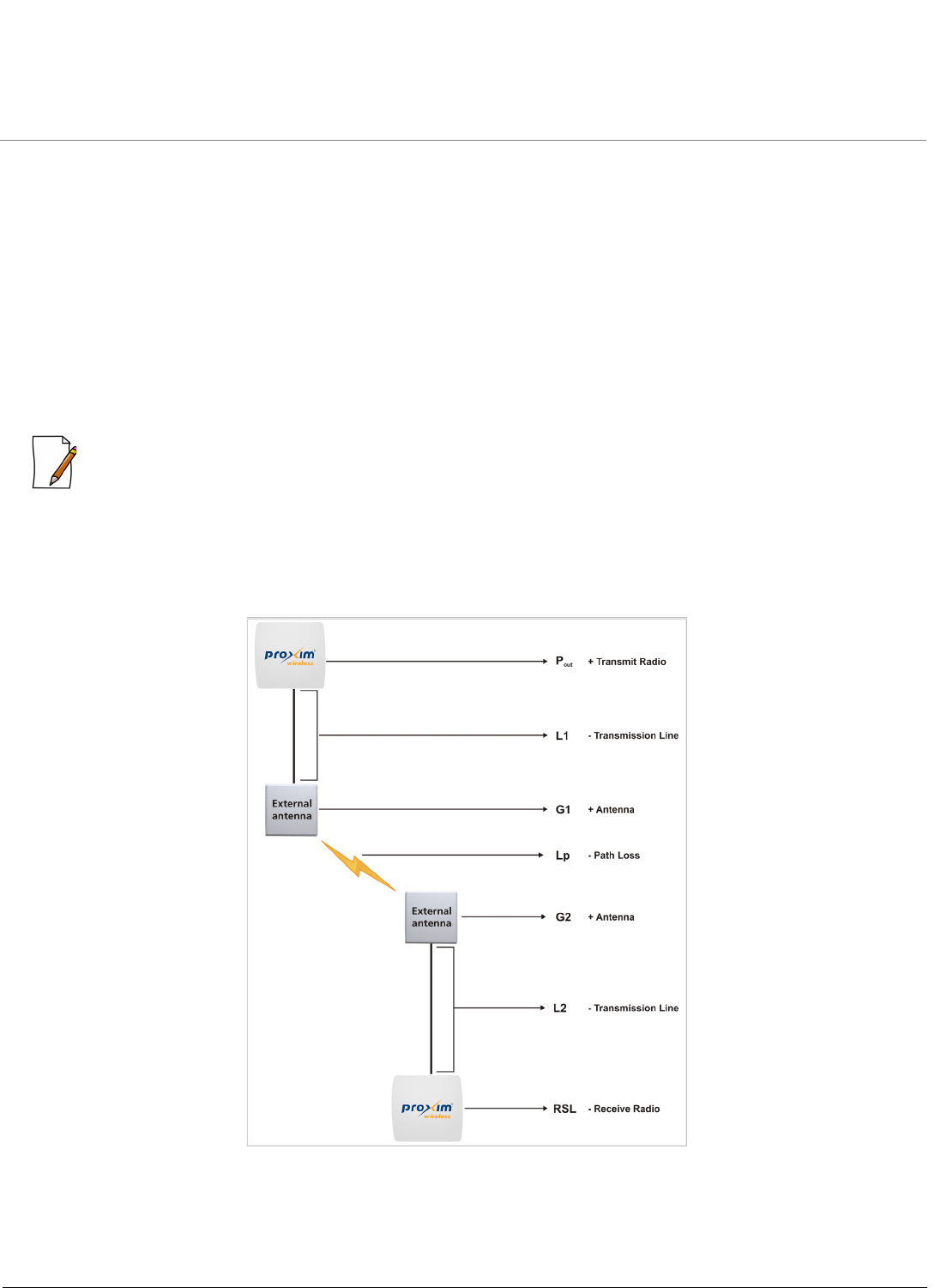
Measuring Signal Performance
Tsunami® MultiPoint 10200 Series - Antenna Installation Guide 24
where:
•Pout is the output power (in dBm) of the transmitter.
•L1 is the total loss of all transmission elements between the antenna and the RF device on one side of the link (in dB).
•G1 is the gain of the antenna on one side of the link (in dB).
•G2 is the gain of the antenna on the opposite side of the link (in dB).
•L2 is the total loss of all transmission elements between the antenna and the RF device on the opposite side of the link (in
dB).
•Lp is the Path loss, defined by:
Lp (dB) = 96.6 + 20 log10F + 20 log10D; where:
–F is the frequency of the radio system in GHz.
–D is the distance of the path in miles.
:
• This formula is available on a calculation sheet provided by Proxim to generate an estimate of link distance and
reliability.
• The path loss must be smaller than the link budget minus the minimum required fade margin. The maximum ranges
cause the path loss plus the fade margin to be the same as the link budget.
The following figure is a pictorial representation of the elements in the Link Budget equation.
Figure 2-4 Link Budget Equation-Pictorial Representation
Procedure
1. Start with the transmit power and the number of the channel to be used in dBm. Subtract the total loss of all transmission
elements between the antenna and the radio on one side of the link (dB).
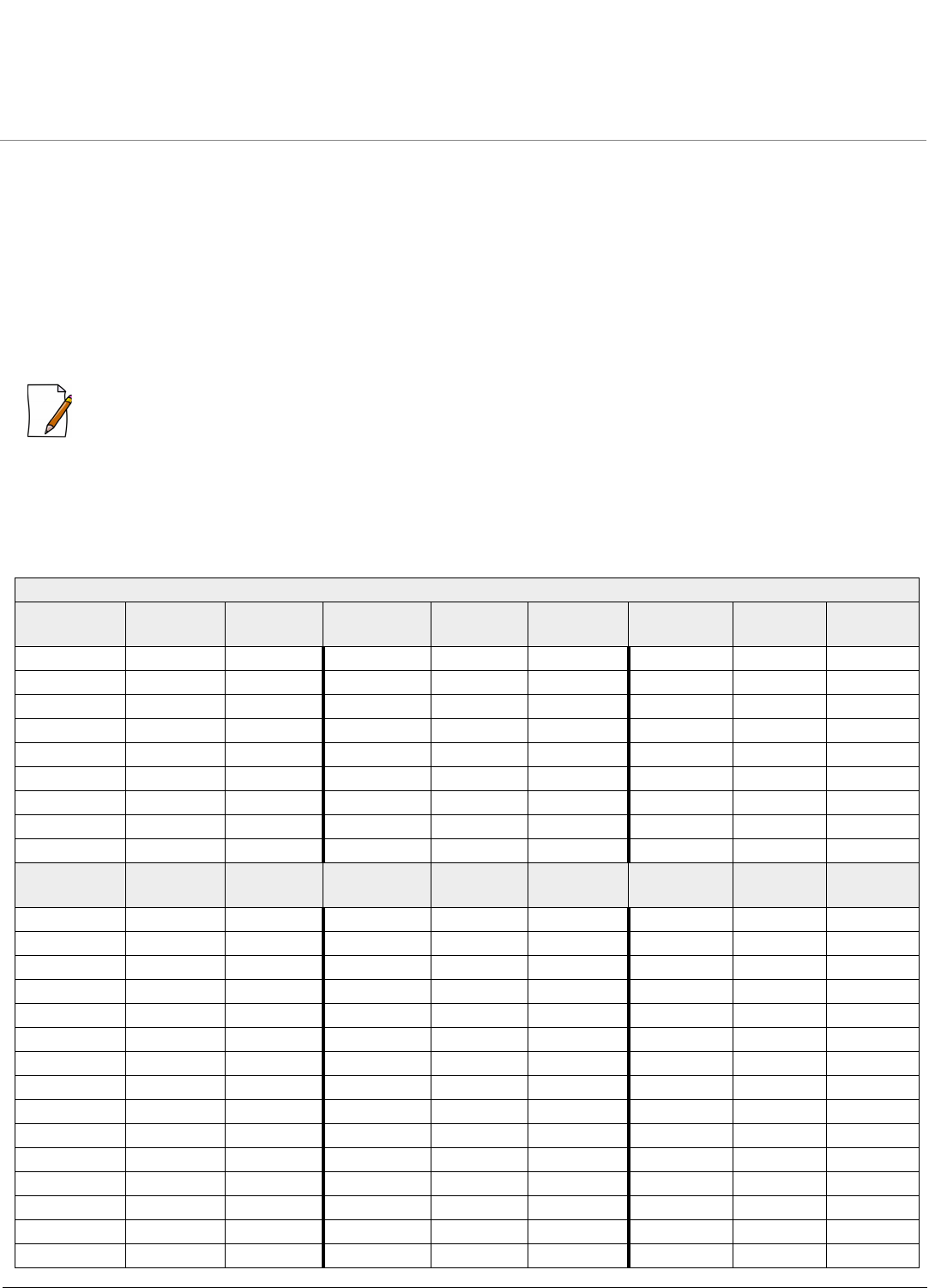
Measuring Signal Performance
Tsunami® MultiPoint 10200 Series - Antenna Installation Guide 25
2. Add the gain of the antenna you will be using. The total is the EIRP (Equivalent Isotropically Radiated Power).
3. Determine the path loss of the microwave link by using the mathematical formula of Lp, illustrated in Calculating Link
Budget.
4. Add the gain of the antenna on the second side of the link.
5. Subtract the total loss of all transmission elements between the antenna and the radio on the second side of the link. The
result is the Received Signal Level (RSL).
6. For details on the receive sensitivity and data rate values used for the wireless link, for details refer to Tsunami® MultiPoint
10200 Series Hardware Installation Guide.
7. Subtract this value from the Received Signal Level; this is the Fade Margin.
:
• The RSL must be higher than the Receiver Sensitivity plus the Fade Margin for a good link. The amount of Fade
Margin indicates the reliability of the link. The more the Fade Margin, the more reliable is the link.
The results of this link budget calculation are very important for determining any potential problems during installation. If you
have calculated the expected RSL, you can verify that it has been achieved during installation and troubleshooting.
Tabulated below is the relation between the Distance and Link Budget, for a selected frequency:
Reference Frequency: 5600 MHz Center Frequency for Europe
Link Budget
(dB)
Distance
(m)
Fresnel
Zone (m)
Link Budget
(dB)
Distance
(m)
Fresnel
Zone (m)
Link Budget
(dB)
Distance
(m)
Fresnel
Zone (m)
61 4.8 0.3 91 151 1.4 121 4.8 8.0
62 5.4 0.3 92 170 1.5 122 5.4 8.5
63 6.0 0.3 93 190 1.6 123 6.0 9.0
64 6.8 0.3 94 214 1.7 124 6.8 9.5
65 7.6 0.3 95 240 1.8 125 7.6 10.1
66 8.5 0.3 96 269 1.9 126 8.5 10.7
67 9.5 0.4 97 302 2.0 127 9.5 11.3
68 11 0.4 98 339 2.1 128 10.7 12.0
69 12 0.4 99 380 2.3 129 12.0 12.7
Link Budget
(dB)
Distance
(m)
Fresnel
Zone (m)
Link Budget
(dB)
Distance
(m)
Fresnel
Zone (m)
Link Budget
(dB)
Distance
(m)
Fresnel
Zone (m)
70 13 0.4 100 426 2.4 130 13.5 13.4
71 15 0.5 101 478 2.5 131 15.1 14.2
72 17 0.5 102 537 2.7 132 17.0 15.1
73 19 0.5 103 602 2.8 133 19.0 16.0
74 21 0.5 104 676 3.0 134 21.4 16.9
75 24 0.6 105 758 3.2 135 24.0 17.9
76 27 0.6 106 850 3.4 136 26.9 19.0
77 30 0.6 107 954 3.6 137 30.2 20.1
78 34 0.7 108 1071 3.8 138 33.9 21.3
79 38 0.7 109 1201 4.0 139 38.0 22.6
80 43 0.8 110 1348 4.2 140 42.6 23.9
81 48 0.8 111 1512 4.5 141 47.8 25.3
82 54 0.8 112 1697 4.8 142 53.7 26.8
83 60 0.9 113 1904 5.0 143 60.2 28.4
84 68 1.0 114 2136 5.3 144 67.6 30.1
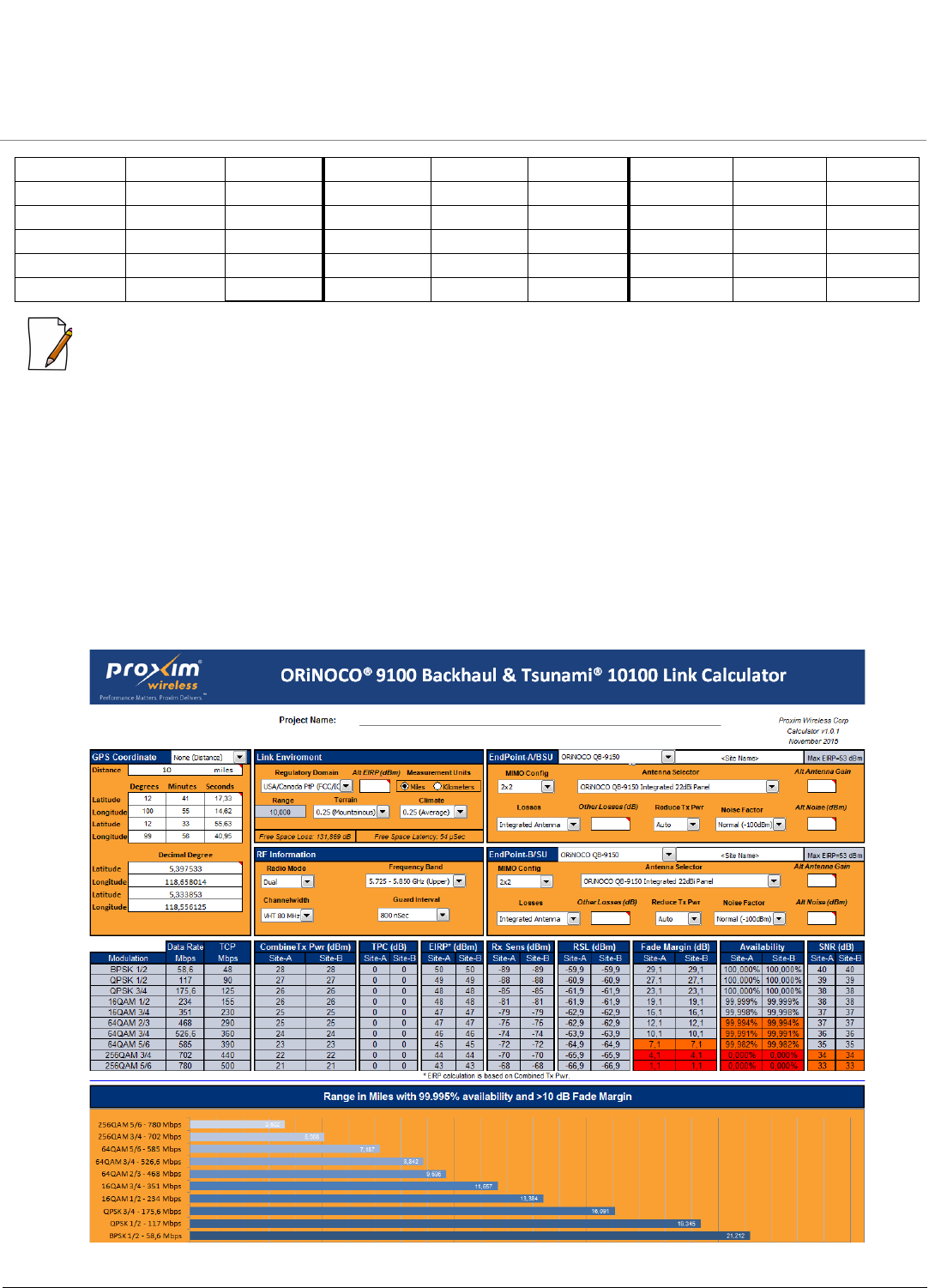
Measuring Signal Performance
Tsunami® MultiPoint 10200 Series - Antenna Installation Guide 26
: The Distance (m) is calculated by assuming the 60% of the 1st Fresnal to be clear.
Effective Isotropic Radiated Power (EIRP)
In countries like USA and Canada, radio can be installed with any directional antennas gain, as there is no Effective Isotropic
Radiated Power (EIRP) limit for the application of these systems for fixed point-to-point applications in the 5.8 GHz frequency
band. In other bands and in other countries, EIRP limits may apply. In the case of EIRP limits, use the lower values of either
(Pout - L1+ G1) or the EIRP limit, within the Link Budget equation. You should check this calculation in both the directions to
assure legal application. An EIRP limit is the maximum RF energy that can be transmitted as measured at the transmitting
antenna and is usually deterwmined by government regulations. For details, we recommend you to refer the Max EIRP values
listed under the Wireless Interface properties, in the Tsunami® MultiPoint 10200 Series - Hardware Installation Guide.
The figure below illustrates the calculation of range through Proxim Link (MP 10xxx) Calculator, available at
http://support.proxim.com, that dynamically adapts the transmit power and receive sensitivity values for a selected product to
follow the local EIRP rule. Click Path Profile tab of the Link calculator to get the path profile information with link elevation.
Figure 2-5 Proxim Link Calculator
85 76 1.0 115 2397 5.7 145 75.8 31.9
86 85 1.1 116 2689 6.0 146 85.0 33.7
87 95 1.1 117 3018 6.4 147 95.4 35.7
88 107 1.2 118 3386 6.7 148 107.1 37.9
89 120 1.3 119 3799 7.1 149 120.1 40.1
90 135 1.3 120 4263 7.6 150 134.8 42.5

Tsunami® MultiPoint 10200 Series - Antenna Installation Guide 27
3
Warranty and Technical Support
For Warranty and Technical Support Policy, please visit http://proxim.com/support.
3.1 Obtaining Technical Service and Support
If you are having trouble using the Proxim product, please read this manual and the additional documentation provided with
your product. If you require additional support to resolve your issue, please be ready to provide the following information
before you contact Proxim’s Technical Services team:
•Product information
– Part number and number of the suspected faulty device
•Trouble/error information
– Trouble/symptom being experienced
– Activities completed to confirm fault
– Network information (What kind of network are you using?)
– Circumstances that preceded or led up to the error
– Message or alarms viewed
– Steps taken to reproduce the problem
•ServPak information (if a Servpak customer):
– ServPak account number
•Registration information
– If the product is not registered, date and location where you purchased the product
: Technical Support is free for the warranty period from the date of purchase.
3.2 Support Options
Proxim Customer Support Website
The Proxim Customer Support Website is available 7x24x365 at http://support.proxim.com.
On the Proxim Customer Support Website, you can access the following services:
•Product Download Page: Provides quick links to product firmware, software, and documentation downloads.
•Proxim TV Links: A link to helpful video tutorials.
•Knowledgebase: A solution database of all the resolved problems. You can search by product, category, keywords,
or phrases.
•Live Chat: Chat with a support technician on-line or request to call back at a later time.
•Create a Support Request: Create a support request with our technical support staff who will reply to you by email.
•Case Management: Login to check the status of your support cases, update your personal profile, or access
restricted information and features.
•Provide Feedback: Submit a suggestion, complaint, or other feedback about the support site and our products.
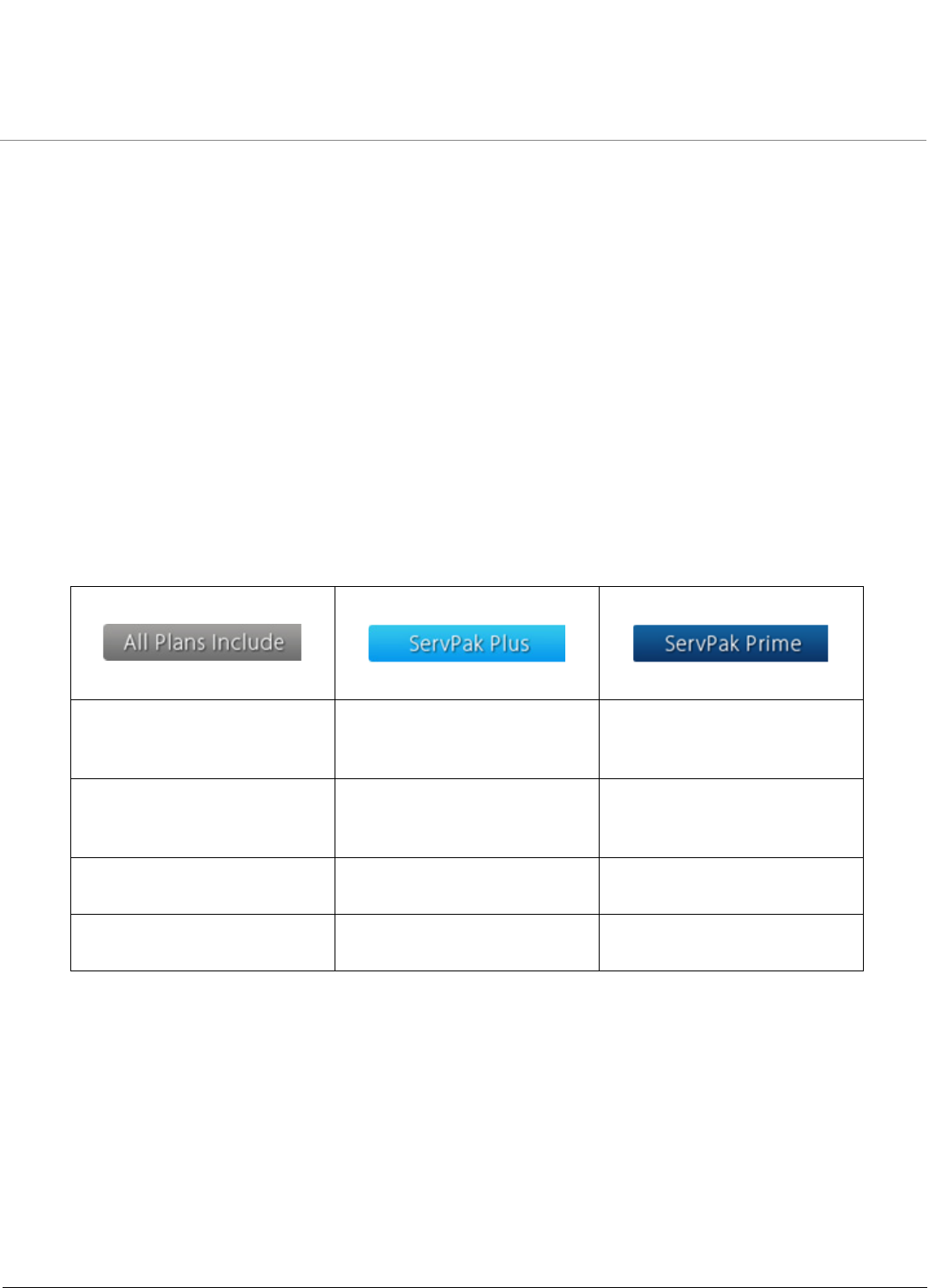
Warranty and Technical Support
Tsunami® MultiPoint 10200 Series - Antenna Installation Guide 28
Telephone Support
Contact technical support via telephone as follows:
USA and Canada Customers
• Phone: +1-408-383-7700; +1-866-674-6626
• Business Hours: Tier 1 support: 24x7 live response. Tier 3 support: 8 a.m. to 5 p.m. M-F PST (UTC/GMT -7 hrs)
International Customers
•Phone: +1-408-383-7700
•Business Hours: Tier 1 support: 24x7 live response. Tier 3 support: 8 a.m. to 5 p.m. M-F PST (UTC/GMT -7 hrs)
ServPak Support
To provide even greater investment protection, Proxim Wireless offers a cost-effective support program called ServPak.
ServPak is a program of enhanced service support options that can be purchased as a bundle or individually, tailored to meet
your specific needs. Whether your requirement is round the clock technical support or advance replacement service, we are
confident that the level of support provided in every service in our portfolio will exceed your expectations.
All ServPak service bundles are sold as service contracts that provide coverage for specific products from 1 to 3 years. Servpak
bundles are considered an upgrade to the standard product warranty and not an extension.
3.3 Additional Information on ServPak Options
Advanced Replacement of Hardware
In the event of a hardware failure, our guaranteed turnaround time for return to factory repair is 30 days or less. Customers
who purchase this service are guaranteed replacement of refurbished or new hardware to be shipped out within one or two
business days, as applicable. Options are available for shipment services depending on the customer’s support needs.
Hardware is shipped on business days, Monday – Friday excluding Holidays, 8:00 AM – 3:30 PM Eastern Time.
7x24x365 Availability
Unlimited, direct access to technical support engineers 24 hours a day, 7 days a week, 365 days a year including Holidays.
24x7 Basic Technical
Support
Basic Advanced Replacement
(Two business days/ International
economy shipment service)
Priority Advanced Replacement
(Next business day/ International
priority shipment service)
8x7 Advanced Technical
Support
24x7 Advanced Technical
Support
Software Maintenance Proxim Vision Support
Access to Knowledge Base

Warranty and Technical Support
Tsunami® MultiPoint 10200 Series - Antenna Installation Guide 29
8x5 Availability
Unlimited, direct access to world-class technical support engineers 8 hours a day, 5 days a week, Monday through Friday from
8:00AM - 5:00PM Pacific Standard Time.
Basic Technical Support
Customers who purchase this service can be rest assured that their call will be answered by Proxim’s Tier 1 technical support
and a case opened immediately to document the problem and provide initial troubleshooting to identify the solution and
resolve the incident in a timely manner.
Advanced Technical Support
In addition to Proxim’s world-class Tier 1 technical support, customers will be able to have their more complex issues escalated
to our world-class Tier 3 technical support engineers. Our Tier 3 engineers will review specific configurations to troubleshoot
intricate issues and will also provide helpful insights regarding Proxim’s products and various tips from decades of collective
experience in the wireless industry.
Software Maintenance
It's important to maintain and enhance security and performance of wireless equipment and Proxim makes this easy by
providing a Software Maintenance program that enables customers to access new feature and functionality rich software
upgrades and updates. Customers will also have full access to Proxim's vast Knowledgebase of technical bulletins, white
papers and troubleshooting documents.
To purchase ServPak support services, please contact your authorized Proxim distributor. To receive more information or for
questions on any of the available ServPak support options, please visit our website at
http://www.proxim.com/support/servpak, call Proxim Support (For telephone numbers, see Telephone Support) or send an
email to servpak@proxim.com.